

Rams rally at Bowditch
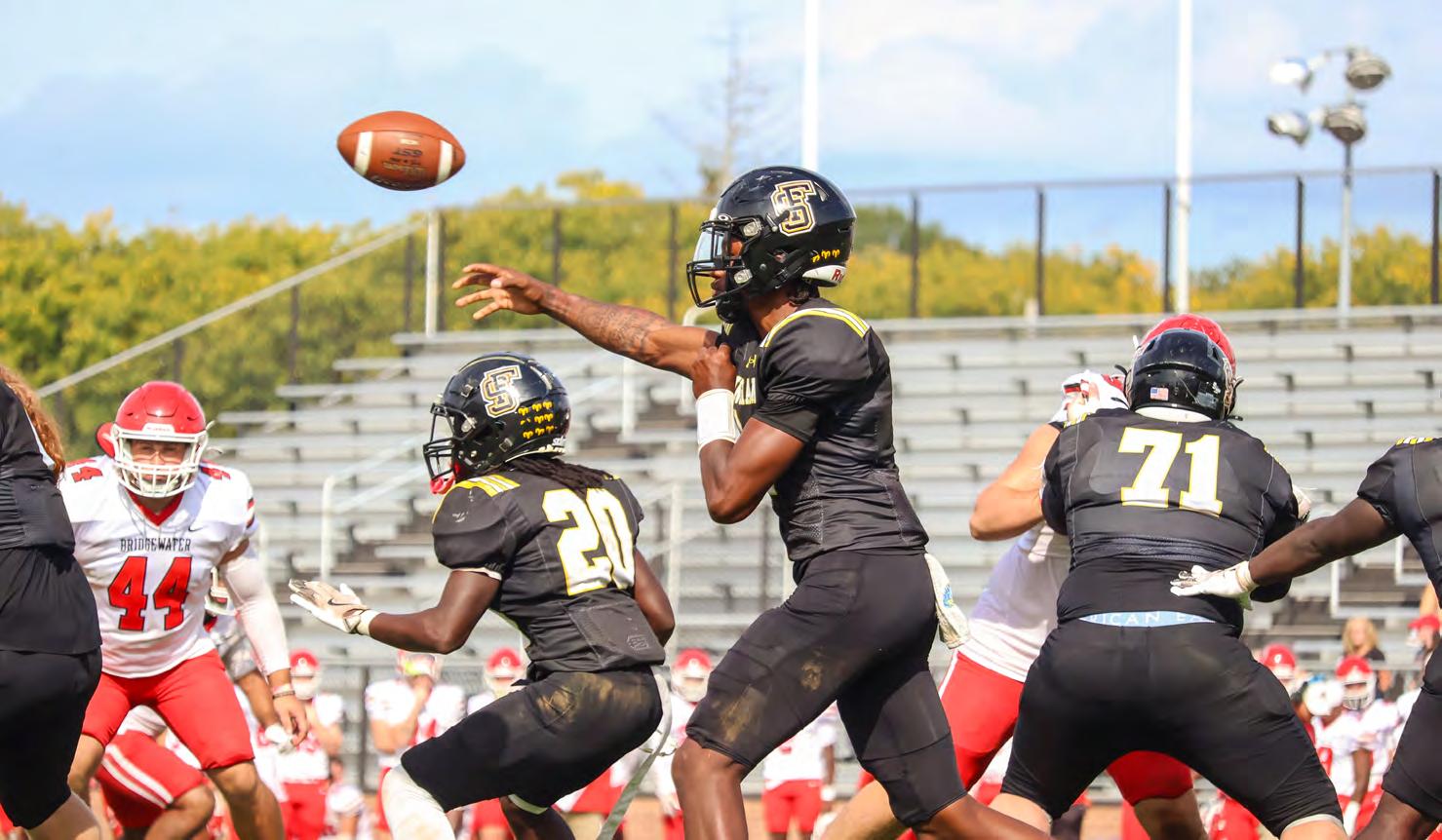
Framingham State preparing for $6.6 million Linsley Hall renovations
By Izabela Gage Editorial Staff
The Center for Excellence in Learning, Teaching, Scholarship, and Service (CELTSS) hosted an event for the Scholarly and Creative Showcase Series: “You Can’t Make These Things Up,” over Zoom Sept. 25.
CELTSS Director Maria Alessandra Bollettino introduced the three speakers, Rachel Trousdale, Patricia Horvath, and Kelly Matthews. Each of them are professors in the English Department, she said.
“Together they will lead us in an exploration of the role of imagination in telling true stories,” Bollettino said.
This skill is important not just for creative writers but many others, such as journalists, scientists, criminal investigators, and more, she said.
Trousdale’s poetry has appeared in several magazines and her book of poems “Five Paragraph Essay on the Body-Mind Problem” won the Cardinal Poetry Prize, Bollettino said.
Her most recent scholarly book is “Humor, Empathy, and Community in Twentieth-Century American Poetry,” she added.
Trousdale said while she is a poet and thus has “poetic license,” she also believes she shouldn’t overdo it.
“If you’re talking about real world subjects, if you’re talking about real world information, it can actually undermine your poem if you deviate too far from verifiable truth,” she said.
She read three poems, “Optics Lab,” “Carboniferous,” and “Units of Measure.”
For “Optics Lab,” she explained what a sestina is. It’s a type of poetic form with six stanzas in which each ends in a preset order of six words.
Framingham State University is set to turn Linsley Hall into below-market housing for faculty, staff, and graduate students, according to President Nancy Niemi.
With $6.6 million in state funding secured this past summer, the University aims to open the redesigned Linsley Hall by spring 2027.
Linsley opened in 1971 and was renovated in 2002. According to an article published in The Gatepost on Oct. 27, 2023, “Linsley Hall to reopen for summer of 2024,” Linsley
Dining
Hall was closed for the 2023-24 academic year and housed students who needed housing over summer break in 2024.
Renovating Linsley Hall is possible because the Commonwealth of Massachusetts has had a buildup of funds in a program called ‘Fair Share Funding,’ which was passed in 2022, according to Robert Totino, vice president of administration, finance, and technology.
According to the Massachusetts Teachers Association, “The Fair Share Amendment … creates a four percent tax on the portion of a person’s annual income above $1 million.”
Totino said the proceeds collected in that fund are ear-
marked for education and transportation projects, and it has grown so large that a supplemental bill was filed by the legislature in the spring of 2025.
He added, “We, as Framingham State, have been trying for a couple of years to get some funding for this initiative, and we’re very fortunate that this has come to fruition.”
Niemi said she was honored by the state’s support for this first-of-its-kind grant and what it means for FSU. “I’m really happy and proud that we can move forward in this.
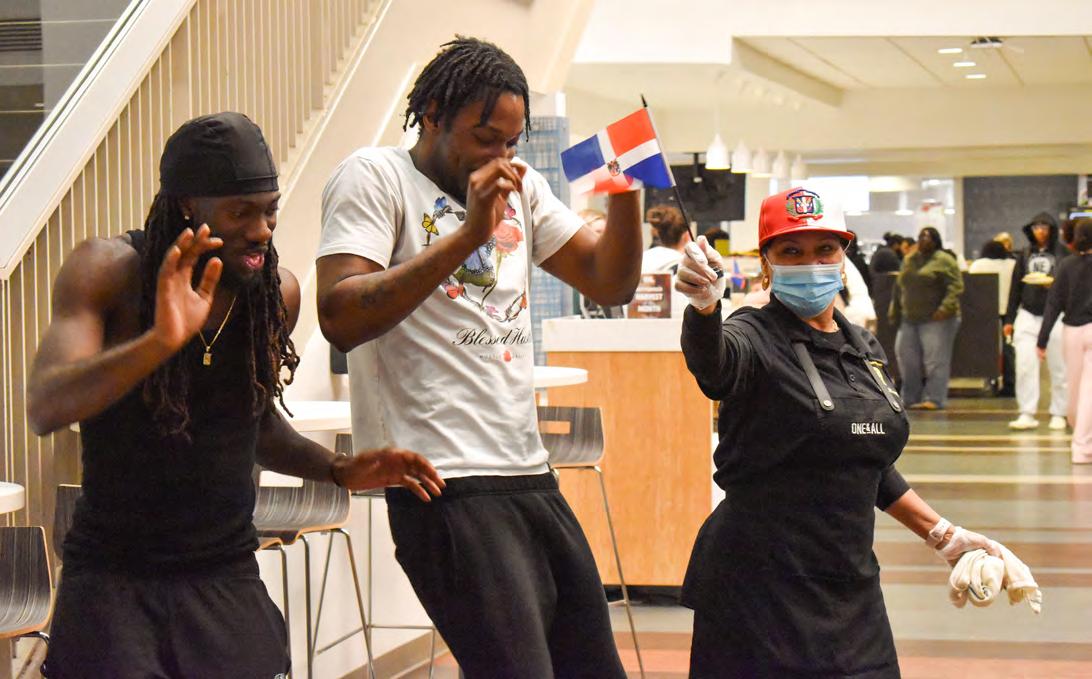
Quarterback Treyvon Fields (center) passing down field in overtime win against Bridgewater St. Sept. 27.
(Left) Kyle Philistin and Javaun Calhoun dancing with dining hall worker, Margarita,
By Francisco Omar Fernandez Rodriguez Arts & Features Editor
E ditorial Board
Editor-in-Chief
Sophia Oppedisano
Associate Editors
Adrien Gobin
Dylan Pichnarcik
Copy Editor Antonio Machado
News Editor
Bella Grimaldi
Opinions Editor
Izayah Morgan
Sports Editor
Izabela Gage
Asst. Sports Editor
Taylor Kimmell
Arts & Features Editors
Francisco Omar Fernandez Rodriguez
Owen Glancy
Asst. Arts & Features Editors
Sarah Daponde
Liv Dunleavy
Photos & Design Editor
Alexis Schlesinger
Editors
Illustrations
Ronnie Chiu-Lin
Marcus Falcão
Staff Writers
Jesse Burchill
Kristel Erguiza
Paul Harrington
Dan Lima
Kate Norrish
Andrew Ramirez
Avery Slavin
Staff Photographers
Meg Dame
Corban Allen
Advisor
Desmond McCarthy
Asst. Advisor
Elizabeth Banks
Graduate Advising Asst.
Emma Lyons



Gatepost Interview Stephanie Logan
Dean of Education and Behavioral & Social Sciences
By Dylan Pichnarcik Associate Editor
What is your academic and professional background?
I started off as a second-grade teacher, and transitioned into school counseling. I worked with students from pre-K to eighth grade as a school counselor. And then I transitioned to higher education full-time, where I served as a teacher-educator, primarily focusing on folks going into the elementary classroom, supporting their efforts in how to teach social studies in the elementary classroom. I also worked with graduate students around multicultural education, cultural competency, [and] a variety of courses that had different titles but ultimately focused on how our schools have served students in the past, how are they serving them in the present, and what are the hopes for the future - while recognizing that education didn’t start for everybody. There was only a certain segment of the population that was allowed to be educated, and some were legally denied education. So taking all of that into mind, that’s the work that I did with graduate students. And I arrived here in June from Springfield College in Massachusetts, where I served as the department chair for education. I went to Morgan State University. It’s a historically Black college in Baltimore. Then I transitioned to Ohio State University for my master’s, and then I actually went back to Morgan for my doctorate.
What brought you to Framingham State?
As I’ve considered my professional trajectory, there’s been something that has been sort of a common theme in regard to my territory being enlarged or the reach that I could have. So when I started off as a classroom teacher, I had my 22 little folks in front of me, and they were great, and I loved working with them. But I sort of wanted more. So then I became a school counselor, and everybody in the school - those were my students. So I had the opportunity, especially because in elementary school, I could go into every classroom. I could interact with all of the students and their families in many ways. And as I transitioned to higher education, while yes, I had a certain
Correction
number of students who sat in front of me each semester, my impact on them would then impact their students. And so now I’m at a place where I get to impact faculty, who impact students, and then
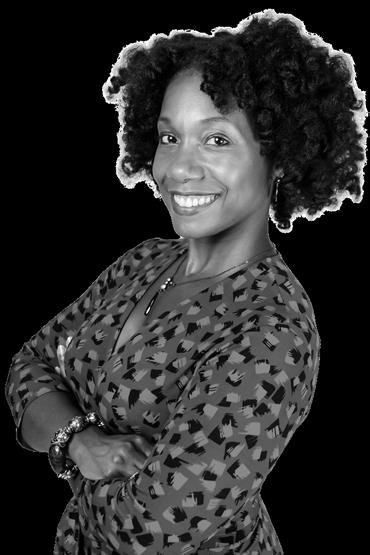
[students] who will impact clients or other folks or students as they go into their particular field. So that’s sort of the trajectory of how I view things. Framingham State was of interest because it’s in Massachusetts, and I already had an understanding of the higher education landscape in Massachusetts. So that drew me to Framingham. Something else that drew me to Framingham is that when I look at the images on the website, too, they reflect what our country looks like. There’s a lot of racial and ethnic diversity here, linguistic diversity, economic diversity, ability diversity, and different expressions in regards to gender and sexuality. So to me, this place reflects the country that I would like to see, or the world that I would like to see. So that drew me to Framingham, as well as some of the information on the website in regards to its commitment to diversity, equity, and inclusion. So those are important features in my own life that have been important in my own practice. And so to see an institution, even at the time that I was interviewing and things were changing a bit in our nation, and to now be here and to know that the commitment is still the commitment, lets me know that I’m good for Framingham and
Framingham is good for me. What do you hope to accomplish as Dean of Education and Behavioral & Social Sciences? Well, it’s not so much me - it’s a collective accomplishment. One of the things that I’ve come to understand is that this idea of having deans is still sort of relatively new and that the configuration of the colleges has changed a bit. So one of the things that I’ve noticed, and am chatting with the department chairs about, other faculty about, the faculty fellows that I work closely with, is how do we create a College of Education and Social & Behavioral Sciences (ESBS) identity where our students recognize that they are part of this college? Certainly, everyone knows, “Well, this is my major,” and that’s important, but they’re also a part of a larger community, which is the College of ESBS. So for the students to see that, but for the faculty to really feel that as well, and then also how we talk to our alumni so that they feel it and know that they are, that they were, but still are a part of a college. When I consider all of the majors and minors in the college, it is about service and service to humanity.
What inspires you about FSU?
My colleagues have been my favorite part. I did enjoy the firstyear student orientation. The fanfare for the first-year students was really, really nice, fun, and organized. So [my] colleagues and I get to see how Framingham does that pomp and circumstance, how traditions are established and carried on.
What is something students may not expect about you?
That I’m approachable. I think that often folks, whether they are students or adults, don’t think that I’m approachable. I’m just always in my head. I’m thinking about several things at once, but I am approachable, I am student-centered and focused, and whatever way that I can be of service to students, that’s what I’m here for. That’s what education is about. How is it that we support students in pursuit of their academics, their careers, and their personal social needs?
CONNECT WITH DYLAN PICHNARCIK dpichnarcik@student.framingham.edu
On page 7 of the September 26, 2025 issue of The Gatepost, two students’ names were misspelled. They were spelled as Marlin Polanco and Micheal Kurtzer, this is incorrect. The correct spelling is Marlín Polanco and Michael Kurtzer. We apologize for this error.
Police Logs
Monday, Sept. 29 11:36 Court Duty, Framingham District Court Call/Assignment Complete
Tuesday, Sept. 30 2:09 Bank Escort, Bank of America Call/Assignment Complete
Wednesday, Oct. 1 3:15 Motor Vehicle Accident, Crocker Grove Report Taken
Wednesday, Oct. 1 10:02 Alarm, Fire, Miles Bibb Hall Unfounded
Courtesy of Stephanie Logan
SGA swears in 16 members
By Dylan Pichnarcik Associate Editor
Student Government Association swore in 16 newly elected members on Sept. 29.
The newly inducted members included a vice president, secretary, publicist, and 13 senators.
In their first official act as a senate, a motion to appoint Jobe Murphy as a senator was made by Events Coordinator Alix Ayoub and seconded by Senator Mari Awuah.
Murphy ran for vice president in the fall election. However, he lost the election to Shubham Valand.
After an “aye” or “nay” vote, Murphy’s appointment as a senator was approved, and he was subsequently sworn in.
During the meeting, SGA President Cesár Matos announced SGA will host a retreat for new and returning members on Friday, Oct. 3, and Saturday, Oct. 4, to familiarize new members with SGA’s rules and procedures.
Matos also asked members of SGA to sign up for University Governance Committees. Including the All University Committee, University Curriculum Committee, and Academic Policies Committee.
After the fall election cycle, Matos said in an interview with The Gatepost that he is pleased with the increase in membership on SGA.
He said he credits Ayoub for the increase in membership.
“A lot of the people that came on this year were thanks to Alix,
and I feel like a lot of the attributions have been made to me, which, you know, is great. I love recognition, but let’s recognize Alix as well. Alix brought in a lot of people,” Matos said.
Ayoub said she worked to invite students she knew to join SGA and promoted membership through social media, physical flyers, and tabling.
According to Matos, approximately 8% of the student body voted in SGA’s fall election.
Last year, approximately 37 students voted in the SGA election, according to Matos.
He said he hopes SGA will continue to grow this semester.
“We’re not doing enough. We are basically in a cycle of getting halfway to everything that we’re attempting to do, and I don’t like finding ourselves in a cycle of getting things half done. We still have 14 empty Senator positions, so we’re still going to find every capacity to ensure that we get those 14 filled,” Matos said.
He said with each new addition to SGA, they will be able to better support the student body.
“I’m hoping that we’re able to finally function at the capacity that we’re supposed to and expand beyond what that is supposed to be,” Matos said.
SGA 2025 Election Results
Vice President
Shubham Valand
Secretary
Ling Zhang
Publicist
Taylor Royal
Senators
Kennedy Thompson
Caleb Connors
Cam Rokes
Mari Awuah
Marwa Sadiq
Des Morris
Xiera Montes
Merlin Clive
Kaylynn Wotton
Salman Karimi
Nathan Piette
Cierra Rosado
Kait Eller
Jada James
Michael Weber
Jobe Murphy
CONNECT WITH DYLAN PICHNARCIK dpichnarcik@student.framingham.edu

Weather

Saturday, Oct. 4 Sunny, with a high near 81.

Sunday, Oct. 5 Sunny, with a high near 83.


Monday, Oct. 6 Sunny, with a high near 81.

Wednesday, Oct. 8 Showers likely. Mostly cloudy, with a high near 71.
Thursday, Oct. 9 Sunny, with a high near 60. Tuesday, Oct. 7 Mostly sunny, with a high near 80.

Dylan Pichnarcik / THE GATEPOST
SGA members at their Sept. 30 meeting.
Niemi reaffirms commitment to DEI at State of the University address
“We are not backing down.”
By Sophia Oppedisano Editor-in-Chief
President Nancy Niemi delivered the first State of the University address of AY 2025-26 on Sept. 29 and spoke about the University’s ongoing commitment to diversity, equity, and inclusion (DEI) initiatives.
She said this was her third State of the University address, and she believes the meetings serve as a platform to share information that “reflects the state of the University” as well as encourage “transparency.”
Niemi acknowledged she wanted to find the balance between announcing how well the University is doing while taking into account that “we’re hurting - higher education is hurting,” she said.
“How do we hit the right spot between knowing that we’re here and we’re strong and we are not going anyplace, even as we also have some hard things that are hitting us?” Niemi asked.
Niemi focused on the fiveyear strategic plan for the University, which is in effect for its second year.
Objectives for this year include leveraging the mission of public good for impact, innovating for student success, nurturing a diverse and thriving community, creating spaces that inspire, and fortifying the University’s foundation for excellence, Niemi said.
This academic year, Niemi said first-year undergraduate enrollment is down 6% after a small increase last year. “I wish I could give you different news, but I’m giving the news we have, and we need to do better. It’s really hard,” she said.
National Student Clearinghouse data on enrollment will become available in October, which Niemi said will give the University answers to account for the decrease.
This data aligns with similar decreases in first-year undergraduate enrollment across the state university system, Niemi said.
First-year graduate enrollment has increased by 12%, and total enrollment remains steady at 3,560 students, Niemi said.
Additionally, retention is up 3%, which Niemi and Lorretta Holloway, vice president of Student Success, confirmed is the highest retention increase since 2014.
“That is great news. It’s got to go higher than that. … We need to have [all students] graduate so that our graduation rate goes above 50% because that remains our percentage, and it’s still unacceptable,” Niemi said.
She said she wants to “empower” students to “persist” in their education in an effort to increase retention and graduation rates.
“That is one of the major markers of equity,” she said.
Niemi added, “It is a crime to have students have some college and no degree and then have debt for that college, and half our students sit in that space. We cannot let that happen.”
Fostering a diverse and thriving community and “embedding a commitment to diversity
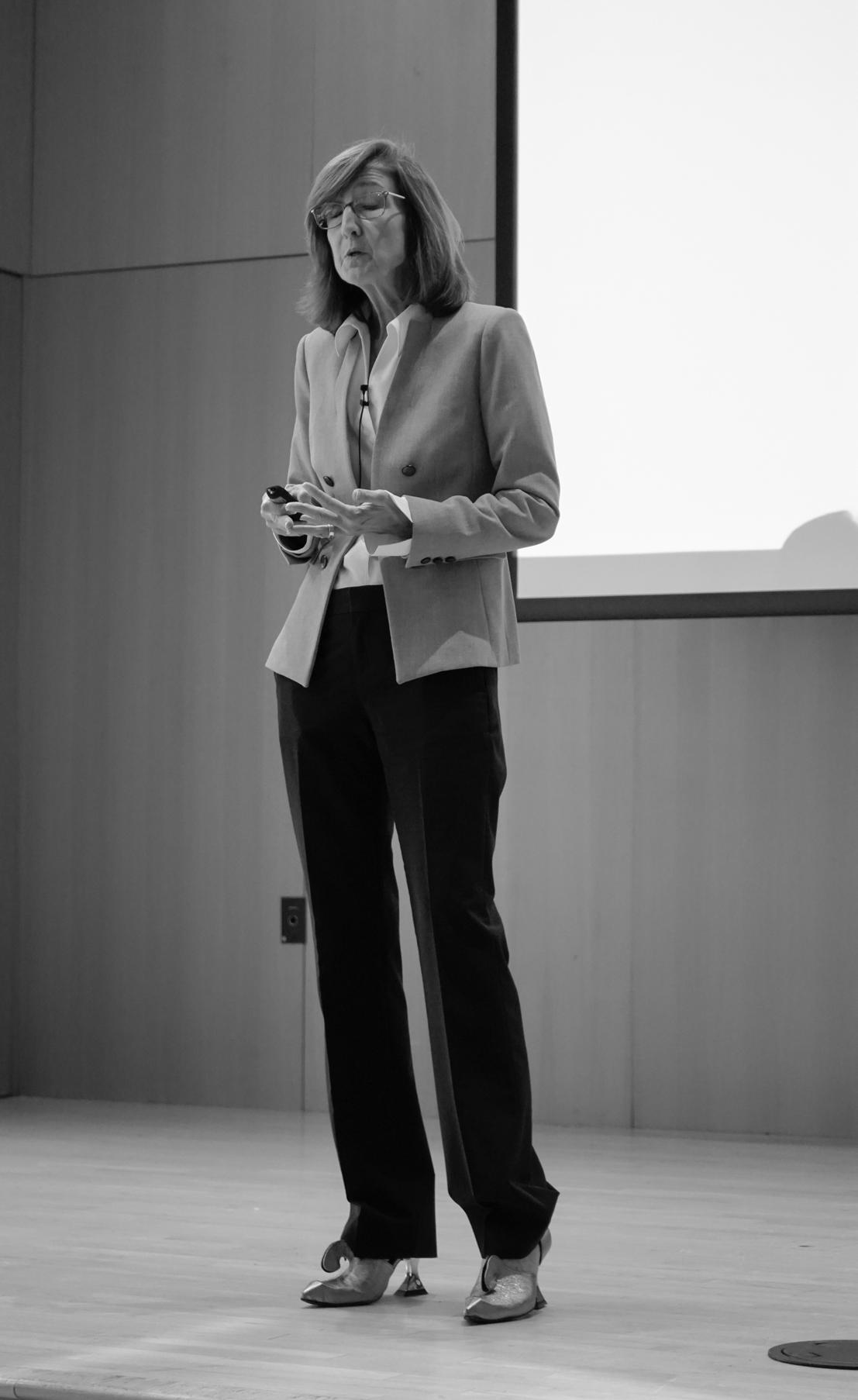
in everything we do” are goals Niemi hopes to be able to measure in an effort to promote “a continuous culture of learning and well-being for all members of our community,” she said.
This includes the objectives in the strategic plan that reference DEI, Niemi said.
Niemi reaffirmed the University’s commitment to DEI. “Our DEI work is absolutely essential to us. … We are not backing down,” she said.
She said she is working on a “Live to the Truth” campaign centered on “making social justice operational.” She also referenced the equity objectives each department and college is using to promote DEI.
Niemi said she is working on observing how faculty and staff use the equity objectives within their work and their departments.
“We’re developing that so we can see [the equity objectives] in real time, within our classrooms and our co-curricular work and co-curricular
initiatives,” she said.
“We are assessing, as we need to, how well these goals are actually executed and how we know we’re doing them,” Niemi added.
Co-curricular work and initiatives include activities such as student organizations and travel, Niemi said.
She said she wants to “help students make sure that they understand that equity is part of that work” within their student organizations.
According to data Niemi presented for AY 2025-26, Framingham State continues to be a majority-minority-serving institution for the second consecutive year. This means “students who identify as BIPOC outnumber our students who identify as white,” Niemi said.
“We are extremely proud of that. … These are the students we serve. We continue to know that and work hard to serve them well,” she added.
As efforts to “enact” being a
majority-minority serving institution continue, Niemi said it is a priority to let prospective students and families know “that’s who we are.
“We had a couple of candidates on campus this fall, and they could not stop talking about the ways in which they physically saw the diversity of all kinds on our campus. They said, ‘You’re not just saying it. You actually live it,’” she said. Niemi added as the University moves forward, it is important the community knows “diversity equals excellence.
“There is no way we’re changing a word of what we do. We are out there. We are proud, and we commit to the DEI work that we built into our DNA,” she said.
Dylan Pichnarcik / THE GATEPOST
President Nancy Niemi at State of the University address on Sept. 29.
FSUPD launches 8th annual ‘Pink Patch Project’
By Bella Grimaldi News Editor
During the month of October, recognized as Breast Cancer Awareness Month, the Framingham State Police Department is launching their 8th annual ‘Pink Patch Project,’ according to Sergeant Harry Singh.
During this month, University Police officers will sell pink patches to raise awareness for breast cancer.
Patches can be purchased using a barcode on the ‘Pink Patch Project’ flyer, which can be found on FSUPD’s social media.
Patches are $10.00, and all proceeds go to Susan G. Komen New England.
Susan G. Komen New England is a non-profit organization that supports breast cancer research and patients.
Susan G. Komen was a breast cancer patient who died in 1980. Her sister, Nancy Brinker, founded the organization in 1982.
According to Singh, FSUPD has worked with the non-profit since 2017, when University Police started participating in the project.
Singh said the patches this year have a new look.
“Somebody asked me, ‘Why do you want to change the patch?’ … Because we always want to bring something new every year,” he said.
He said the new design was made through Dirty Water Collectibles, a custom patch, pin, and decal shop based in Saugus.
According to Singh, Domenico Montano, an officer in the Saugus Police Department, designed the new patches.
“He’s really creative. He does patches, he does coins - he’s done our Ramsey coin. And then he has done our department coins,” he said.
Singh added for the first time, University Police officers are wearing pink and gold badges for Breast Cancer Awareness Month.
In past years, FSUPD officers wore the same patches given to
donors on their uniforms. This year, officers wear exclusive badges designed for the department, according to Singh.
“Like I say every year, our goal is to keep doing better. Our goal is to keep growing. Our goal is to show that we care and we want to give back to our community,” said Singh.
For the month of September, FSUPD wore black-and-gold patches for Childhood Cancer Awareness Month and to support the Jimmy Fund, according to a social media post from University Police.
The post said this cause “holds a special place in Officer [Steven] Martel’s heart as his son Kole was diagnosed with leukemia at 11 months old and has been receiving treatment [through] the Jimmy Fund for almost two years.”
Martel said this is the first year FSUPD has collaborated with the Jimmy Fund.
According to their website, the Jimmy Fund is a fundraising community that works to support the Dana-Farber Cancer Institute and its research.
Kole’s mother, Courtney Martel, said the family was referred to the Jimmy Fund from the UMass Memorial Medical Center in Worcester.
She said their family has worked with the Jimmy Fund since 2023.
According to Courtney Martel, she and her husband contacted the FSUPD chief about wearing the patch to raise awareness for childhood cancer.
“I have seen ‘Go Gold’ in other police departments and I wanted to implement that here because you guys do ‘Pink Patch,’” she said.
Martel said he saw another municipality from Holyoke wearing childhood cancer awareness patches.
According to Courtney Martel, the Martels made the design and Dirty Water Collectibles created the patch.
She said her goal in collaborating with FSUPD was to raise donations for the Jimmy Fund
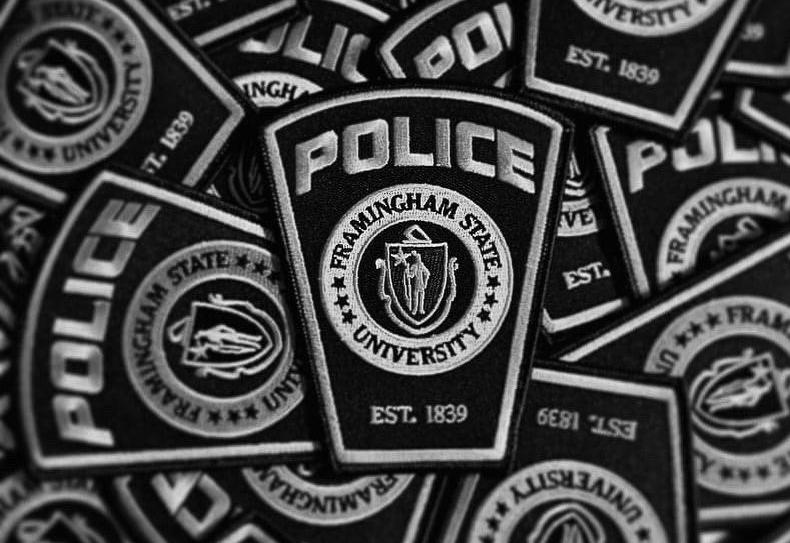
and to raise awareness for childhood cancer.
According to Singh, they raised $617.25 from selling the childhood cancer awareness patches.
“The whole point behind all of this is to raise awareness. People don’t realize how much childhood cancer is underfunded and not talked about enough,” said Courtney Martel.
Singh said, “We just want to give back. I think giving back is one of the nicest things we can do as a human being. We want to give back to the cause and no matter what the cause is, I think it just stands out.”
According to Singh, FSUPD will be wearing patches for the month of April to spread awareness for autism.
He said this is the first year FSUPD will be wearing these patches.
Singh said, “We’re representing our students, staff and faculty, not just our officers. At the end of the day, that’s why we do what we do.”
Graduate student Olivia Putnam said she didn’t know University Police were raising awareness for breast cancer.
She added, “I feel like there’s not enough awareness for stuff like that. And anything helpsso many people pass away from different cancers. More needs to be done about it.”
Freshman Jasiel Cólon said he hadn’t heard of the Pink Patch
Project but believes it is important to raise awareness for breast cancer.
Freshman Maria Vitoria Machado said she supports FSUPD raising awareness about childhood cancer and autism.
She added she feels good about FSUPD raising awareness for breast cancer through the Pink Patch Project.
“I think we should spread more awareness because not a lot of people know about it and it is important,” she said.
Freshman Julian Lison said FSUPD raising awareness through the project “is great. They should keep doing it.”
Sophomore David Forgione said he believes it’s a good idea to raise awareness about breast cancer.
“I think it shines a really good light on our police department when they do things outside of the Framingham State community to benefit everyone,” he said.
He added he believes its good FSUPD is raising awareness about childhood cancer and autism because they are underfunded areas.
Forgione said, “I think we need to raise awareness as much as possible because no kid deserves to go uncared for.”

Continued from Page 1
This is a special project. … I know we’re the first state university to do this, and it feels wonderful to make a bigger community.”
Totino said, “We’ve been advocating for this as a great project because housing right now is in high demand across the state and across the nation, too.”
Niemi said the first reason University officials initiated this project is the cost of living in Massachusetts, because over the time she has worked at FSU,
University is more than simply a place to work - that we can have it as a place where you can truly live as well.”
Totino said this approach may include not only current staff, faculty, and graduate students, but also educators in the region, including those who work in Framingham Public Schools or at The Learning Center for the Deaf.
Niemi said she has had conversations with agencies in MetroWest and Framingham that need housing. “I think that can still happen, but it would
what the market rates are by then.
Totino said the University might have to limit the number of cars the residents in Linsley can park on campus.
He added because of the transportation options near and on campus, the University will see if residents can use public transportation rather than rely on personal vehicles that would have to be parked on campus. “It’ll be a multi-faceted approach to make sure that we can meet the needs of the residents in that building.”
and professors in such an easy way is really attractive.”
She added having a community for graduate students closer to resources gives them a better chance at academic success as well as a built-in social life.
Senior Nick Messina said having staff, faculty, and graduate students on campus “helps strengthen the community because of everyone being in proximity.”
He added he thinks it’s “innovative” for FSU to be the first state school to offer housing at affordable rates for its own
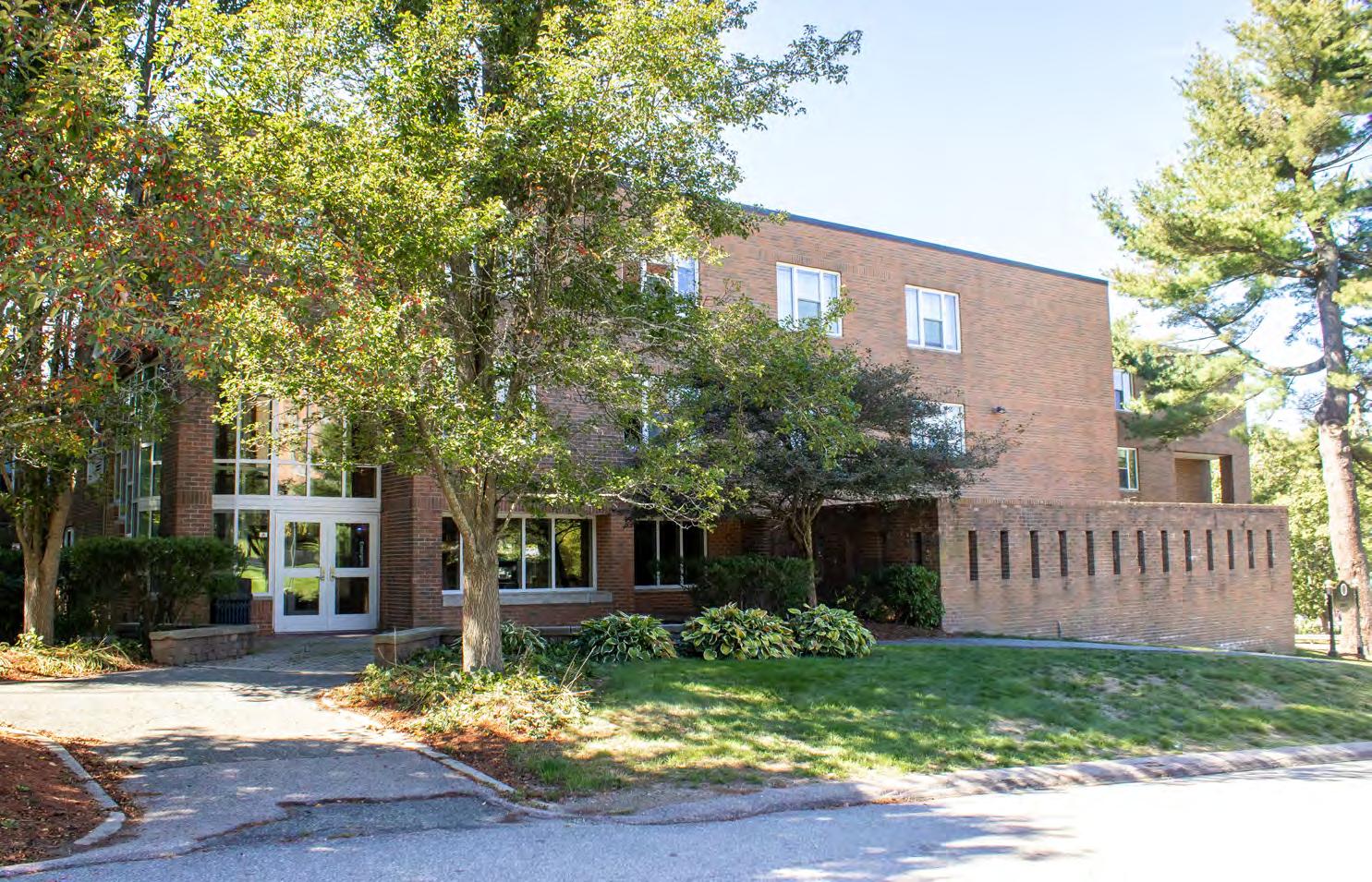
she has learned housing in this area is hard to find or too expensive.
Totino said housing struggles have already cost the University potential hires. “President Niemi did inform me over the summer that we were looking at hiring a couple of new faculty for the fall, but they turned us down because they could not find housing in the area that fit their price range.”
Niemi said, “We can pay people what we think is a reasonable wage, but the housing market doesn’t match the salary often.”
The lack of short-term housing adds another layer to the problem, according to Niemi. “There are people who live in other parts of the state, or lovely New England, who work here and need a place to stay for the week. … You don’t want a whole apartment with its expense if you’re going to be here for the week, but you go home on the weekend. So there’s another need we have.”
Niemi said, “The other part of it is a community idea that universities are communities - little cities in and of themselves. So we have this amazing public infrastructure - we have places to eat, we have a library, we have a gym, we have communal spaces outside and inside - so why not have a place where people who work with us also want to be part of that community?”
Niemi said a sense of belonging is central to the project, because “living well and as part of a bigger community matters. We want to take that seriously and offer opportunities that our
have to be for area educators in some capacity because that’s what we have to do, and that’s who we are.”
Linsley Hall is the only residence hall of the seven on campus that has air conditioning.
Totino said, “We’re going to be able to put air conditioning in Larned Hall, probably for the summer of 2026.”
Niemi said putting air conditioning into Larned Hall “will allow us to raise our summer housing capacity, which we find that we need. It’s getting warmer for longer, and we can house more people in the summer with that.”
Totino said of the $6.6 million appropriation, University officials will be using over $1 million to retire the outstanding debt on Linsley Hall, “which is going to be another great savings overall for the cost to operate that facility.”
According to Totino, the final design will include 32 apartments - 20 studio units supported by shared kitchens on each floor and the rest as twoand three-bedroom apartments with their own kitchen facilities.
Totino said, “We don’t have anyone on board at this time, but we will be engaging with an architect and a construction company because there are two big projects - Larned and Linsley.”
Niemi said the price range for the units is still undetermined because University officials have to take into account the two years in between now and when the apartments will be available, and it depends on
Administrative Assistant for the Division of Graduate Studies and Continuing Education Heather Jones said she lived in an apartment in Foster Hall for a year.
“There’s so much public transportation in this area, and the price wasn’t bad. … You got internet, electric, basically everything, for $1,500 a month, which in today’s economy is really good,” she said.
Jones said being able to be a bigger part of the community was very nice, especially because she was a club advisor, so she could help them when they needed it.
Jones said, “We need employee housing, because there’s a housing crisis right now … and I’m glad that they are actually taking the initiative to do that.”
Junior Indigo Allain said, “I think the summer housing will improve once it is moved to Larned because the building can house more people, and the rooms are a good size.”
Allain said she thinks it’s important that Framingham State is recognized for offering apartments at below-market rates, “as it allows graduate students and faculty to continue their education and work with the benefits of affordable housing.”
Post-baccalaureate teacher licensure program student Eileen Moynihan said, “The advantage of having the library so easily accessible would be huge. I know that’s definitely a point of concern for me when I’m doing projects and writing papers, which is how often I can get to the library, so I think having access to resources like the library
Schlesinger / THE GATEPOST
community.
Junior Shelbie Greenaway said she thinks it’s exciting to see Framingham State take this leap. “It shows that our school is not only focused on academics but also values its students and staff. It is a step in the right direction, and I think once this is implemented, other schools may begin to follow.”
English graduate student Allie Mosher said, “Offering staff and faculty housing is a great idea, since they typically work here a lot longer than students attend classes here, meaning it would offer them some stability in being able to commit to their jobs.”
As a commuter for most of her time at FSU, she said, “A space on campus definitely encourages students to engage more with campus activities and events. It can feel a little isolating, so that would be nice.”
English graduate student Sam Stafinski said allowing graduate students to live on campus “will give students more headspace to focus on their studies in a space that values academic rigor.”
Niemi said the project offers an opportunity to rethink the relationship between universities and the people who make them run. “I’m excited about how this changes a bit of the model as to how we educate people and the people who help make it happen. I’m very excited about it and very grateful.”
CONNECT WITH IZABELA GAGE igage@student.framingham.edu
Alexis
Linsley Hall.
OP/ED
Commuter students deserve better
THE GATEPOST EDITORIAL
Commuter students have always been an important and active part of Framingham State’s community.
Student enrollment data posted to framingham.edu shows 48% of the student population commuted to campus in the fall of 2023 - the last semester for which this data was publicly posted.
Unlike resident students, commuter students do not have designated spaces on campus to hang out with friends, attend Zoom classes, or eat a balanced meal at a low cost.
There are a few shared spaces available to commuter students.
The Whittemore Library is a great resource and a fantastic space on campus for students to relax or study. However, first and foremost, it is a space that promotes academic achievement rather than a location to gather and socialize with friends.
Other public areas, such as the study spaces in Hemenway Labs, the tables on the second and third floors of the McCarthy Center, and Ram’s Den Grille, lack space and amenities for commuter students and serve more aptly as places to study or spend one-on-one time with a friend. These spaces are located in highly trafficked areas, unlike the secluded lounges and study spaces offered to residents.
Larned Beach, Miles Bibb Lawn, and the green space in front of May Hall are not accessible year-round, and club rooms are locked and reserved for students who belong to specific organizations.
The student lounge, located on the third floor of the McCarthy Center, is a space that is specifically designed for commuter students, but it is not adequate to serve the large commuter population.
The lounge features a cluster of tables, a row of desktop computers, and a printer that is renowned for being broken most of the time. The lounge - really a room - is quite uninviting and is yet another space that feels geared toward academic tasks rather than social opportunities.
Visually, it is unappealing and unwelcoming. It is small and ill-equipped for the 48% of the population who commute.
Amenities such as a fridge, games, and even a TV monitor students could connect their phones and laptops to would make the space more akin to the lounges resident students have access to in the residence halls.
Commuter students deserve a space to gather that is more significant and appealing than this.
All of the spaces referenced in this editorial can be accessed and used by resident students, but commuters do not have any space that is strictly for themselves in the way resident students do.
In the past, there has been more dedicated space for commuter students. For example, before the area now known as Magellan’s was constructed, the space was a large Commuter Caf where commuters could socialize throughout the day and after hours.
Prior to 2006, almost the entire fourth floor of the McCarthy Center was dedicated to student organizations, with other spaces allocated for student club use throughout the building. Now, while there is still dedicated space for The Gatepost, Student Government Association, WDJM 91.3, and the Framingham State Activities Board, there are only three open, dedicated club rooms that can be used by any student organization on campus. All of them are outfitted with limited furniture and materials and are tucked away from where the average commuter might frequent.
Club Room I is constantly in use, which is a great indicator that students want to be involved during the day and after hours, but it should show the administration that students need more space due to such high demand. Club Room I has a projector and USB hookup for students to use, as well as limited lounge seating.
In comparison, Club Room II does not feature the same amenities available in Club Room I, and is frequented less often by students due to its conference-room-style setup and storage space.
Events targeting commuters are also scarce. Resident Assistants in the residence halls are required to host a set number of events for residents throughout the semester. There is no program like this that specifically produces events designed primarily for commuters.
In addition to inadequate events and a limited amount of dedicated space, commuters struggle with access to dining options.
The cheapest meal plan option for commuter students is $270 for 25 meal swipes per semester. Commuter students deserve to have a nutritious meal during the school day and this plan only accounts for 25 meals over a 16week semester.
The Gatepost Editorial Board believes there should be a more streamlined program for resident students’ unused guest swipes to be used by commuter students who are on campus every day and cannot purchase a meal plan.
Rams on the Run or the green-box meals provided by the Dining Commons are both resources that should be made more widely accessible to commuter students who cannot afford a full meal plan.
While resources that promote student success and wellness are bountiful at Framingham State, this issue comes down to the fact that commuter students do not have much keeping them on campus and engaged in anything other than their academic goals.
College is supposed to be a place where you can meet people, take part in on-campus events, and gather with friends after a long day in class.
The Gatepost Editorial Board is urging the University not to overlook commuters’ place on this campus. They deserve more attention and time, as well as dedicated, welcoming spaces.
Regardless of whether Framingham State’s students live on or off campus, everyone deserves to be able to feel at home here.

Adrien Gobin / THE GATEPOST
The student lounge on the third floor of the McCarthy Center.
Campus Conversations
“What is your go-to hangout spot on campus?”
By Dylan Pichnarcik, Associate Editor and Izayah Morgan, Opinions Editor
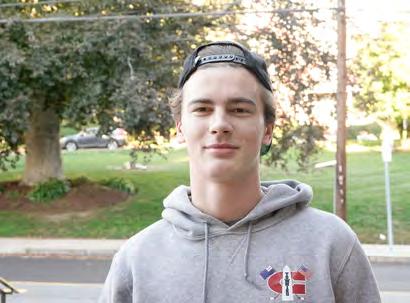
“I would say Benny’s room in Larned.”
- Cullen Lacey, freshman
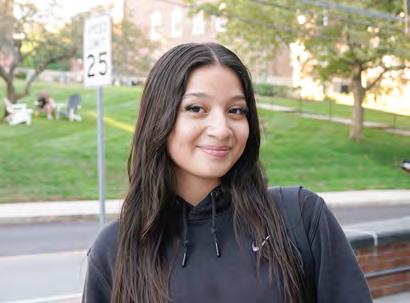
“Either my dorm or the seats right outside May.”
- Joanna Miranda, freshman

“I would say my room but also the dining hall.”
- Benny O’Keefe, freshman

“I like the seats right outside near the dining hall.”
- Devani Taylor, freshman
Are Tylenol and autism linked?
By Izayah Morgan Opinions Editor
Last Monday President Trump stood tall next to Health and Human Services Secretary Robert F. Kennedy Jr., as information was presented on factors that may contribute to the uptick in autism diagnoses.
According to the National Institute of Mental Health, “[Autism] is a neurological developmental disorder that affects how people interact with others, communicate, learn, and behave.”
Additionally, this can be diagnosed later in life but generally symptoms tend to appear early in a child’s development so medical professionals can diagnose patients early.
Many have called these claims from Trump into question such as Mikhail Varshavski, a boardcertified family physician (also known as Doctor Mike on social media), and Alok Kanojia, a psychiatrist with over 3 million subscribers on YouTube.
Additionally, U.K. Health Secretary Wes Streeting said he trusted experts more than President Trump in this case.
Even former President Barack Obama criticized the Trump administration’s comments stating the claims have been disproven many times. He said, “what’s being trumped by these massive increases, actually has to do with a broadening of criteria on that spectrum.”
Trying to solve why autism has seen a massive increase in
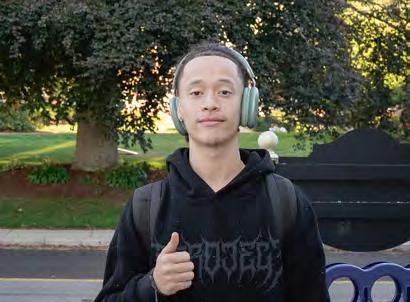
“Probably right behind Bibb’s, that little hoop that’s there.”
- Willmani Castillo, senior

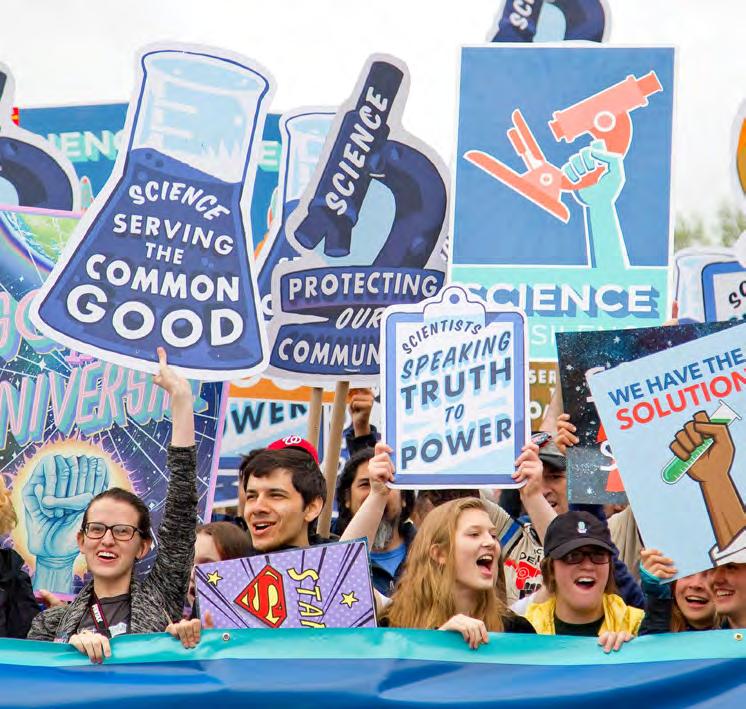
diagnoses over the years is an admirable goal and is important. However, I have problems with how the data was interpreted by Trump and his cabinet. As an undergraduate student, I don’t offer medical adviceI trust the experts. However, as a psychology major, I have taken multiple research, statistics, and math courses where I learned to conduct research, analyze data, and read studies.
One of the most important things we learned when conducting research is to watch out for confounding variables.
Confounding variables can be defined as variables that cause
conflict between the dependent and independent variables in a study. Often these can be the reason people think a correlation is larger than what it actually is. The first example I learned was that as ice cream sales increase, shark attacks increase as well.
It’s not because rightfully people consume more rocky road ice cream, so sharks want to attack more. Rather, as ice cream sales go up, what else changes? The weather. With an increase in temperature so does beach going, which inevitably results in more shark attacks.
These are exceedingly rare, according to the Florida Mu-
seum that investigated 88 cases worldwide, with only four fatalities a year. However, certain media outlets fuel the belief that sharks are more dangerous than they are.
With that being said, autism has no single cause as it is partly genetic and possibly environmental. However, trying to associate the increase in autism diagnoses doesn’t make sense to me. Think about the reason pregnant women even take Tylenol during pregnancy - they are facing possible sicknesses and Tylenol provides relief.
The National Library of Medicine did a thorough review of over 100 research papers where they found “most of the literature agreed on the possible effects of the viral infection during the critical period of development on the risk of developing autism.” Pregnant women are not just popping Tylenol for fun, there is a specific health issue they are trying to relieve. What was touted as groundbreaking information just feeds misinformation, distrust in experts and fuels anxiety in expecting and new parents. Silence is violence against the unseen, but these words, as former President Obama said, are “violence against the truth.” Talk with your general care practitioner about the risks and possible side effects of the medicine you are taking.
Trust the experts and get your child diagnosed.
“The chairs in the front of May Hall.”
- Kimberly Ayala, freshman
SPORTS
Volleyball sweeps Fitchburg in conference match
By Taylor Kimmell Asst. Sports Editor
By Antonio Machado Copy Editor
The Framingham State Rams swept the Fitchburg State Falcons 3-0 in a conference matchup Oct. 1.
This victory increases the team’s win streak to five, with the two most recent matches being conference wins against Worcester and Salem.
Freshman Kristina SantiagoAlers served the first ball of the game, with Fitchburg return ing the ball and putting the first point on the board.
Framingham quickly fought back, earning points on two kills by junior Natalie Reynolds and a kill by Captain Stella Bailey, a senior.
Several more errors by the Rams allowed the Falcons to even the score 5-5 before soph omore Madysen Cedrone stole back the lead with a kill, as sisted by Bailey.
Fitchburg matched Framingham’s pace, ex ecuting two service aces and a kill to combat a service ace from Bailey and two kills from Cedrone and junior Emma Dob bins.
A kill each by sophomore Sar ah Medeiros and junior Jamie Moniz as well as two more by Reynolds kept the Rams in the lead for the next few plays be fore the Falcons fought back to tie the score again at 16-16.
A kill by Fitchburg and an other by Moniz tied the score again on the next play.
However, following another kill by Cedrone, Framingham held the lead for the remain der of the set, with kills from Moniz, Medeiros, and Reyn olds as well as a service ace by Captain Carly Beau lieu, a senior, bringing the score to 25-20.
The second set opened with a kill by Reynolds on an as sist by Bailey, start ing the Rams off on a high note.
The dynamic duo of Bailey and Reynolds collaborated on two more kills, keeping pace with the Falcons.
Fitchburg pulled ahead on the next few plays, tallying three kills and a service ace.
Junior Anneli DiVirgilio contributed to the score with two perfect service aces before an error by Fitchburg on the next play ended the set, with Framingham winning by a landslide of 25-15.
The Falcons struggled to lift off at the beginning of the third set, leading to a 2-0 headstart for Framingham after multiple errors from Fitchburg.
However, Fitchburg quickly regained their footing following a kill and an attack error from Framingham, matching
kill by Reynolds, assisted by Bailey.
Fitchburg refused to allow Framingham to dominate, responding with two kills of their own and giving the Rams a sixpoint lead.
Reynolds, assisted by Bailey, offset the Falcons’ offense, but two errors from the Rams helped Fitchburg close the gap.
A kill from Fitchburg only ignited the Rams’ dedication to winning, leading to a kill by Cedrone and an error from the Fal-
the conference at this point definitely sends [other teams] the message that we are not a team that should be overlooked.”
Bailey said, “The team and I have a strong desire to beat every team we play, especially teams in the MASCAC. We’ve been working so hard in the gym and on the court. We all know that our hard work will get us to the number one spot!
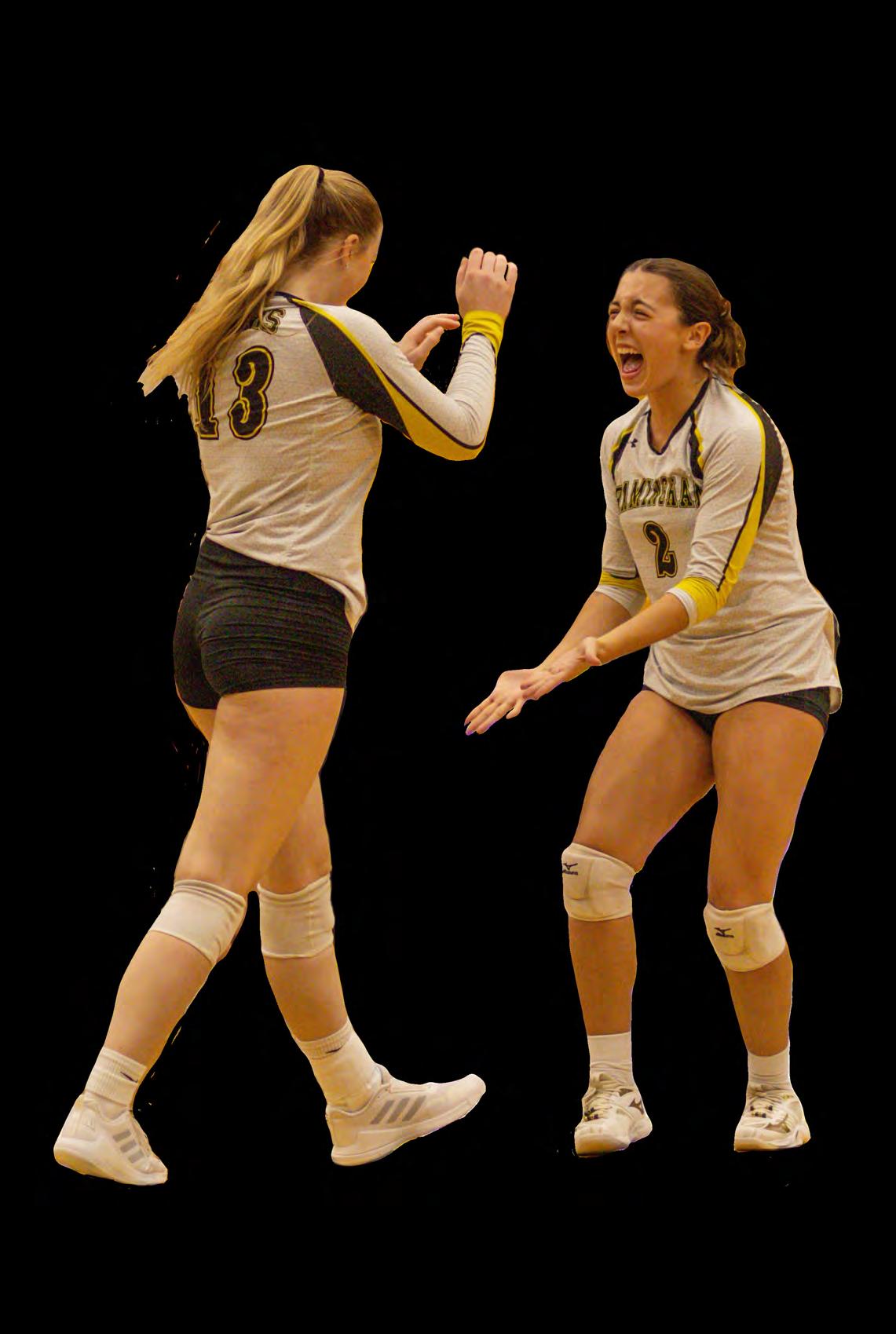
The teams kept a consistent pace, with Fitchburg holding the lead until kills from Medeiros, Reynolds, and Cedrone and a service ace from Reynolds allowed Framingham to pull ahead 13-12.
Two Fitchburg errors added points to Framingham’s side of the scoreboard, causing the exhausted Falcons to take a much needed time out.
Unfortunately for Fitchburg, the errors continued to pile up, allowing Framingham to capitalize on plays and add more points to the board.
Bailey assisted a kill by Moniz, deepening the deficit of the second set for a score of 22-15.
into the lead.
After two attack errors from the Falcons, the Rams found their pacing and began to widen their lead with a kill from Dobbins, assisted by Cedrone, and two service aces from Bailey, bringing the score to 12-6.
The Falcons combated Framingham’s volley of points with two kills, but attack and service errors kept the Rams in a 15-8 lead.
An attack error from the Rams and a service ace from Fitchburg helped the Falcons regain momentum, until they were disrupted by a service error.
The Rams responded to the Falcons’ efforts to catch up with a service ace by Beaulieu and a
ing the Rams second in the con ference.
Bailey said she hopes this is just the start of the team’s success this season. “We talked a lot in preseason and during the offseason about what type of team we want to be both on the court and mentally. The girls aren’t here to mess around - we’re here to win.”
Beaulieu said such a high placement in the conference is “definitely a confidence booster. It gets us prepared for the teams that we’re going to be playing.
“We’re going to play hard teams like Bridgewater and Westfield, and I think it gives us more drive,” she added.
Medeiros said, “Being 3-0 in
“We want every game to be our best game, to keep on pushing us to a higher level of play. We have teams that are traditionally very tough opponents that we are about to play, and we are just ready to get in and fight. Good games are what we live for,” she
Santiago-Alers said she hopes the Rams’ success shows their opponents that “we’re the best in the league.”
Santiago-Alers’ performance during the last set of conference matches earned her MASCAC’s Rookie of the Week award.
Santiago-Alers said she feels earning the recognition “demonstrates my hard work. I’ve been working really hard to improve my game and help the team. I feel really happy that my work is being recognized.”
Bailey contributed 29 assists, 10 digs, four service aces, and a kill during the match against Fitchburg. Beaulieu added seven digs and two service aces. Beaulieu said the team was able to draw upon some strong points from last week’s matches. “Our defense was good. If our defense is on and we’re able to get [the ball] to Stella, that’s when our offense can be on as well.”
Beaulieu said she and Bailey are grateful to be role models for the younger members of the
“It’s a matter of being able to look at the person next to you and know that they’ve got you. … It’s good for the girls to have someone to look up to - a lot of the girls look up to Stella, too,” she added.
Santiago-Alers said, “We have a really good team bond. We have good chemistry, and I feel like with every win, we keep learning and we keep working hard to improve
Coming into the doubleheader this weekend, Medeiros said it will be important for the team to play clean and aggressive, and “not let them get a lead on us. “It will be important to play hard on our side of the net regardless of what’s going on on the other side of it,” she added. The Rams will face off against Saint Joseph’s College of Maine and the University of Saint Joseph in an away doubleheader Saturday Oct. 4.
Stats sourced from fsurams.com and MASCAC.com
CONNECT WITH TAYLOR KIMMELL tkimmell@student.framingham.edu
CONNECT WITH ANTONIO MACHADO amachado4@student.framingham.edu
Men’s soccer falls to Gordon
By Izabela Gage Sports Editor
By Avery Slavin Staff Writer
The Rams were defeated by the Gordon College Lions 2-0 in a non-conference matchup Oct. 1.
This loss brings their overall record to 4-6-1 and their conference record remains at 1-3.
Framingham was strong on offense from the beginning, with junior Kaio Santos Da Silva taking the first shot on goal only 40 seconds in.
The Lions took control of the ball and tried to find the back of the net less than a minute later, but the ball was stopped by freshman goalkeeper Colin Holt.
Sophomore Walbee Pieree responded with an attempt to put the first point on the board less than 30 seconds later.
After 5 minutes of both teams fighting for possession of the ball, Gordon earned a corner and broke through Holt’s defense to find the back of the net, bringing the score to 1-0.
The Rams made it into the Lions’ defensive zone, and after a shot from Pieree bounced off the crossbar, Santos Da Silva went for the rebound, but the shot was high.
Gordon fought for possession of the ball and won, and fired off two shots in a minute in hopes of finding a way around Holt, but was unsuccessful.
Following a foul on Framingham, Gordon was strong in the defensive zone and took
two more shots, one flying high above the net, and the other being stopped by Holt.
The Lions didn’t let up, and only 5 minutes later, made a shot that got past Holt and into the goal to strengthen their lead to 2-0.
The Rams fought for the ball for the next two minutes, but the Lions stayed consistent.
Gordon’s Luke Lindas rocketed the ball toward the goal, but Holt ran toward it to make the save.
Framingham ended the half with three more shots on goal, all of which were saved by Lions’ goalkeeper Isaiah Diaz.
Holt started the second half strong with a save within the first minute.
Shortly after, freshman Michael MacDougall unleashed a shot towards the Lions’ net, only to be saved by Diaz.
About five minutes after an offside against Gordon, Pieree attempted a corner kick, only for a foul to be called.
The Lions sent three powerful shots toward the goal within three minutes, all of which were unsuccessful.
After a few substitutions from both sides, Gordon’s Max Cardone sent a shot toward the net, but couldn’t get around Holt.
Following a missed corner kick from Gordon, Holt, MacDougall, and freshman Shawn Amposah received yellow cards.
The game concluded after two high shots and an unlucky corner kick from the Lions.
The Rams fought hard, not allowing a goal for Gordon in the second half. The final score was

2-0.
Sophomore Thiago Magalhaes said after halftime, “the mentality was the most important. After our coach talked to us in the locker room, I think everyone came back with a lot more energy. The subs also helped us a lot with putting new energy on the field.”
Santos Da Silva said, “Our record, in my opinion, doesn’t show what we have done this season. Right now, we have a positive mindset and confidence that in the upcoming games with other players who are returning, we can get back to full form.”
Sophomore Landon Medeiros said, “Sticking to our brand of soccer and being more organized as a unit will help us offensively and will help us with our possession as well.”
Magalhaes said, “We’re working on defense, on shape, on tactility, and the energy is there.”
He added, “I’m just happy to
be here.”
Medeiros said that as captains, he, Santos Da Silva, and Magalhaes try to look at the positives rather than the negatives.
Santos Da Silva said the three of them “try to keep a positive mindset toward the games that don’t go our way, but also make sure we keep ourselves and everyone else accountable to do better.”
The Rams travel to Suffolk University for a non-conference matchup Oct. 7.
Holt said, “We have to keep communicating in the gamestay focused and always look for the next play.”
CONNECT WITH AVERY SLAVIN aslavin1@student.framingham.edu Stats sourced from fsurams.com and MASCAC.com
Football defeats Bridgewater in overtime
By Taylor Kimmell Asst. Sports Editor
By Sarah Daponde Editorial Staff
The Framingham State Rams defeated the Bridgewater State Bears 46-40 in an overtime conference match Sept. 27.
This victory improved the Rams’ conference record to 3-0 and their overall record to 3-1, ranking them second in the conference.
Winning the coin toss, the Bears chose to defer to the second half, punting the ball all the way to the Rams’ 13-yard line.
Sophomore Jaheim Daniels capitalized on the next two plays, rushing the ball to FSU’s 38-yard line.
Three completed passes from freshman quarterback Michael Marcucella to junior wide receiv-
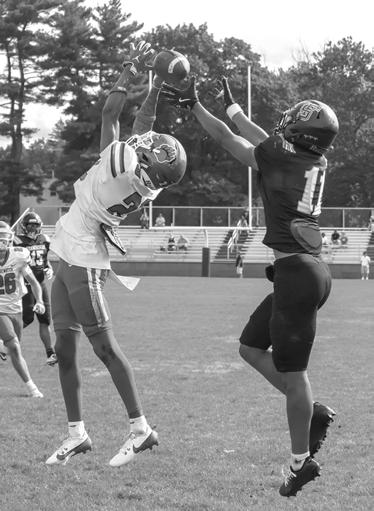
ers Ayden Ramirez and Ezana Zemene and sophomore Ty Kelley earned more yardage for Framingham, placing the ball on BSU’s 31-yard line.
On second down, after a rush by Daniels, Marcucella and wide receiver Alex Maia, a junior, connected on a pass to the endzone, earning Framingham the first touchdown of the game.
Senior Dillon Mangus kicked for the Rams, earning the extra point to bring the score to 7-0 at the end of the first quarter.
Several passes from Marcucella in the second quarter put the ball on BSU’s 40-yard line.
Unfazed by the distance, Daniels caught a pass from Marcucella in the endzone to score a second touchdown.
Despite tackles from sophomores Korrey Barron and Tyrell Fuller, Bridgewater’s offensive drive proved successful as they scored their first touchdown.
Two more offensive drives from the Bears yielded a lead change coming into halftime, BSU leading with a score of 2114.
The Bears lost possession of the ball just 1:33 in, when on third down with 2 yards to go, an incomplete pass brought the ball back to the Rams.
On second down, the Rams continued straight to the endzone with a drive culminating in 71 yards gained and a touchdown by Daniels. An attempt at the extra point by Mangus was unsuccessful, leaving the Rams behind by one.
On their next drive, the Bears drove toward the end zone and
scored a field goal on fourth down.
Key plays from the Rams’ offense on the next drive placed junior Mathias Fowler in position to score another touchdown for Framingham, gaining the Rams a three-point lead.
Bridgewater’s next play resulted in another successful field goal attempt, tying the game 2727.
In the fourth quarter, sophomore Treyvon Fields and Ramirez connected on a pass that brought the Rams 19 yards from the endzone.
On fourth down, Fields made another pass to Ramirez for a revelling touchdown, bringing Framingham back into the lead, 33-27.
On their next possession, the Rams drove to the endzone once again, and as Fields completed yet another pass to Ramirez, a touchdown was secured.
Mangus’ kick was successful, boosting the score to 40-27 Framingham.
Bridgewater made a partial comeback with a pass of 71 yards to the endzone, scoring a touchdown and extra point.
The Bears’ next possession yielded an additional touchdown, tying up the game and bringing it into overtime.
Play began with an incomplete pass by the Bears and a loss of 12 yards. Williams intercepted the ball on fourth down.
Framingham’s drive began with 25 yards to the endzone.
Jarvin Simon, a junior, rushed 6 yards on the first down, and Daniels rushed another yard in
CONNECT WITH IZABELA GAGE igage@student.framingham.edu
the second.
On a jubilant pass from Fields to Maia for 18 yards, the Rams scored the game-winning touchdown, ending the match with a final score of 46-40.
Maia said this game-winning play will be one of his favorite memories of football.
During the match, Marcucella completed 17 of 21 passes, accumulating 192 yards for Framingham. Additionally, his passes earned the team three touchdowns.
Marcucella’s impressive performance earned him the title of MASCAC Rookie of the Week Sept. 30.
Marcucella said earning the title felt “great! We have a great coaching staff and group of players around me, so it’s really a team award.”
Following this victory, Maia said he hopes other teams will “realize that this isn’t the same Framingham as last year.
“Being 3-0 definitely brings hope to the team. … Most teams in our conference have had close games as well, so we take every opponent seriously and continue to practice hard to outwork them,” Maia added.
The Rams travel to Fitchburg State University for a conference matchup Saturday, Oct. 4.
CONNECT WITH TAYLOR KIMMELL tkimmell@student.framingham.edu
Meg Dame / THE GATEPOST
(Center) Michael Macdougall moving down the field with the ball in loss against Gordon College Oct. 1.
Adrien Gobin / THE GATEPOST (Right) Ayden Ramirez about to make a touchdown in win against Bridgewater State Sept. 27.
Women’s soccer stuns Salem in shutout win
By Izabela Gage Sports Editor
The Rams triumphed over the Salem State University Vikings in a 2-0 shutout Sept. 26.
This win evens out their conference record to 2-2 and brings their overall record to 3-4-2.
Sophomore goalkeeper Savannah Goba said this shutout win “felt amazing. We worked so hard as a team for the whole 90 minutes of the game, and not letting up a single goal was so rewarding.
“Our program has always been fueled by determination, but these successes are great boosts to our confidence. Every single player on our team is so dedicated and puts in 110%. And this feeling of a great win is something that will push us even harder to keep earning that feeling,” she added.
After the first three minutes of both teams fighting for possession, sophomore Isabella Fischer had the game’s first shot on goal, with the ball sailing just wide of the net.
At 9:31, the Rams earned their first corner kick, with freshman Sophia Thimm stepping up to deliver.
Moments later, Thimm nearly put the Rams ahead, firing a shot that Salem’s goalkeeper, Ava Guyer, caught at 9:59.
Salem responded shortly after with a shot on goal of their own, but Goba easily blocked the ball from getting past the goal line.
From there, the momentum swung back to the Rams.
Sophomore Abigail Pratt’s 15th-minute shot demanded another save by Guyer, followed by another attempt by Thimm just 21 seconds later.
The Vikings tried to counter, but the shot was wide. Goba remained unshakable and blocked another shot at the 19:25 mark.
Framingham’s pressure mounted, creating a rhythm where Salem was constantly on the back foot, scrambling to clear corners and shots.
Junior Melissa Romeiro pushed forward with two shots in quick succession, with one high and the other wide.
Freshman Sarah Bashore, Thimm, and Romeiro tested Salem’s back line, with each of them attempting to find the back of the net, but all shots were wide.
Junior Tarynn Smith nearly broke through at 34:56, only for Guyer to make yet another save.
Finally, the breakthrough arrived. In the 38th minute, Smith sent the ball downfield to junior Ana Serrano. Serrano chased after the ball, and once she had the breakaway, she slotted the shot into the net for the game’s first goal.
Serrano said, “Scoring definitely gives me confidence, but more importantly, it shows the progress we’re making as a team. The goal came from good ball movement and everyone doing their job, so it motivates me to keep working hard, put myself in the right spots, and help create more chances for us as the season goes on.”
The Rams continued to press in the final minutes of the half.
Freshman Anilyse Laderwager sent the ball wide, followed by two last attempts by freshman Abigale King and Laderwager that Guyer saved before the halftime whistle blew.
Salem opened the second half with urgency, but once again, the Rams responded to the offensive push.
In the 47th minute, Goba stopped a goal attempt from McKenna Gilligan, reinforcing the Rams’ strong defense.
Every time Salem tried to find their footing and even the score, Goba remained assertive in the net.
Romeiro forced another save from Guyer in the 49th minute, and Framingham continued piling on the pressure.
Salem countered with a brief push, but Goba stopped Salem’s Jenna Mitza’s shot on goal at 51:08.
By the 54th minute, Framingham was back in control.
Freshman Leiyani Buckner attempted to find the back of the net, testing Guyer once more before Thimm saw back-to-back shots blocked around the 55th and 58th minutes.
The Rams stayed on top of the ball, keeping the Vikings pinned deep, with two more attempts by Thimm and one by Romeiro.
Romeiro tallied four shots in the game. She said, “Even when I’m not scoring, I try to stay locked in and look for chances. Fast games can be tough, but I just focus on creating space, making runs, and putting myself in a position to help the team whenever I get the ball.”
In the 67th minute, the Rams deepened the deficit.
After Salem absorbed the waves of pressure from Framingham’s offense, Romeiro found
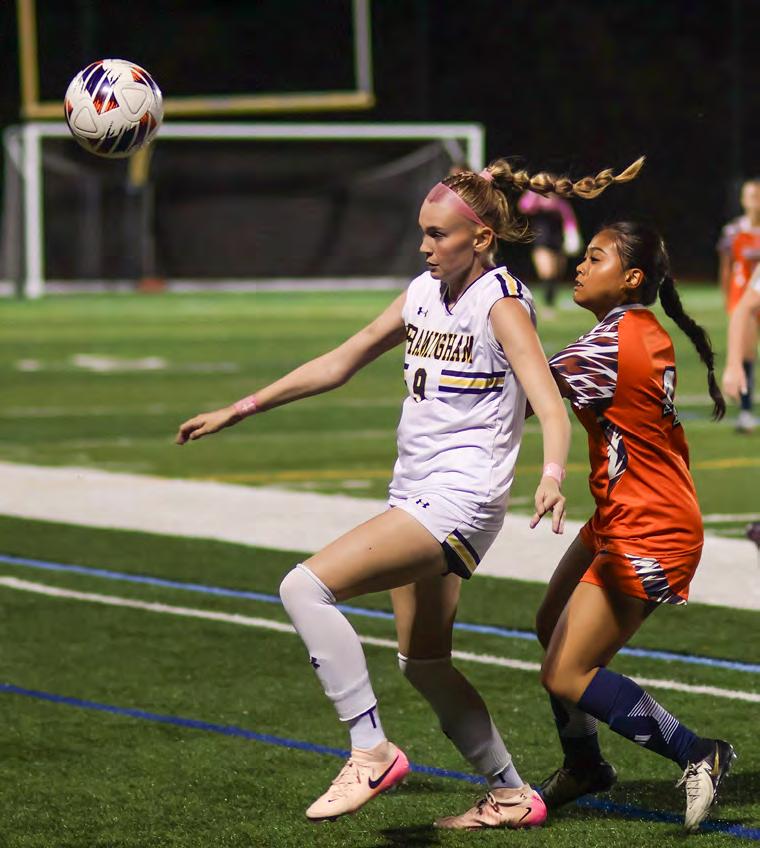
space to serve a perfect pass to Thimm.
Thimm struck it past Guyer to net the ball and give Framingham a 2-0 lead, earning her first collegiate goal.
Thimm said, “Getting that goal definitely boosts my confidence. It shows me that if I keep taking my chances, there is more of a chance of me scoring again, so it motivates me to stay aggressive and keep looking for opportunities.”
Salem tried to close the gap, but every attempt to put their first point on the board was either blocked by the Rams’ back line or halted by Goba.
In the 72nd minute, Captain Grayson Tellier, a senior, took a shot at goal, sending the ball just high of the net.
As the clock wound down, Salem pushed their offense forward, but could not find a breakthrough.
Gilligan’s 88th-minute attempt flew wide, and moments later, Salem’s Hudah Ngoy Nkulu tried to find the back of the net, only for Goba to once again make a save.
Serrano said, “Our coaches always emphasize playing simple and keeping possession, and I think that really showed in this game. Everyone bought into the game plan and trusted each other, which helped us control the pace and create a lot of scoring opportunities with 24 shots.”
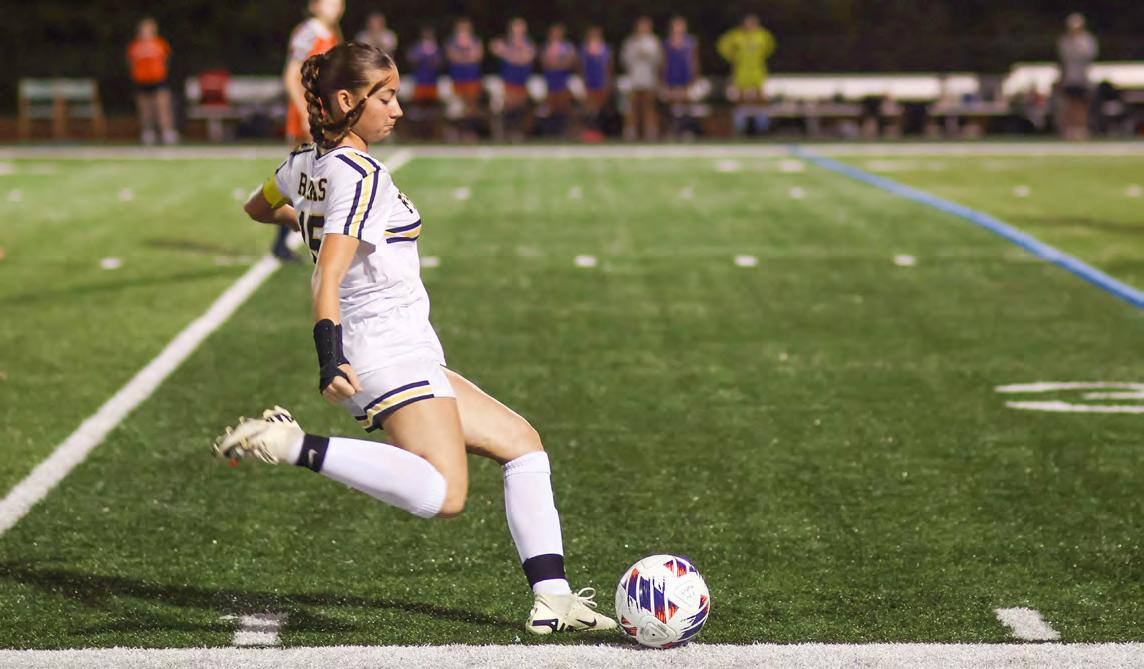
Romeiro said, “We worked on connecting passes, switching the field, and staying aggressive in the final third, which helped us keep pressure on and create so many chances.”
Thimm said to control possession and create more scoring opportunities throughout the win, the team “focused on moving the ball quickly, keeping good spacing, and staying patient on offense.”
Goba said, “Because of this great group of girls, I feel that our team is prospering in growth. It takes a collective effort for a team to function, and there’s no one better for the job than the girls on this team.”
The Rams hosted the Keene State College Owls in a non-conference contest and lost 1-0 Oct. 1. This loss brings their overall record to 3-5-2, and their conference record remains at 2-2.
Framingham hosts the University of Maine at Fort Kent for another non-conference matchup Oct. 4.
Goba said the team is working hard to continue building momentum for the rest of the season. “We are focusing on bringing high intensity to every practice to push each other to be the best we can be.”
Serrano said, “These non-conference games are great to build momentum as we push toward playoffs.”
Romeiro said the team is working on staying consistent for the full 90 minutes and improving as a unit so they are prepared for conference play.
Thimm said, “We’re working on communication, keeping up our intensity for the full game, and finishing out our chances. If we keep improving in those areas, it’ll help us in our non-conference games this week.”
Goba said, “I truly believe that this team has such strong chemistry off the field, and that translates to chemistry on the field. Our team is like a family - we respect each other so much, and we believe in each other.”
Adrien Gobin / THE GATEPOST
(Left) Tarynn Smith preparing to make contact with the ball in win against Salem State Sept. 26
Adrien Gobin
Abigail Pratt kicking the ball in win against Salem State Sept. 26.
The right to be forgotten - author discusses gilded-age book ARTS & FEATURES
By Sarah Daponde Asst. Arts & Features Editor
Maura Jane Farrelly held a discussion about her recently published book, “Compliments of Hamilton and Sargent: A Story of Mystery and Tragedy on the Gilded Age Frontier,” on Sept. 30.
The event was hosted in the Alumni Room and over Zoom.
Yumi Park Huntington, program coordinator, said this was the first event in the Arts and Ideas series to be hosted this academic year. It was organized with the help of Mirari Elcoro, professor of Psychology, and Joseph Adelman and Sarah Adelman, professors of History.
Senior History major Isabelle Atherton introduced Farelly, a Brandeis University associate professor and chair of American Studies.
Atherton said Farrelly’s book “focuses on the Gilded Age and looks at prehistoric elites to show the 19th century change in an individual’s ability to hide from society.”
Farrelly’s book is the 2025 winner of the Spur Award in the Best Western Historical Nonfiction section, she added.
Joseph Adelman said he and Farrelly would be discussing the book in a “live podcast interview” format.
The book features three characters, and two main locations - the East Coast and Wyo-
ming, Joseph Adelman said.
“One of the things I enjoyed most about the book is just how rich and complex the story becomes as you develop it,” he added.
Farrelly said her idea for this book began when she found a photograph in her grandmother’s house in 2012. “Edith Sargent” was written on the back.
She said she eventually found a letter to the editor of the New York Times written by Edith Sargent in 1913, which she wrote to say she was offended by the way the paper had written about her husband’s death.
Her husband, John Dudley Sargent, became another one of Farrelly’s main characters.
Robert Ray Hamilton, the great-grandson of Alexander Hamilton, was her third main character.
“Everyone loved to read about the scandalous Hamiltons,” Farrelly said.
The book follows the lives of these prominent individuals as their reputations were tarnished, according to Farrelly.
In 1630, it was easy to disappear into the “uncivilized” West and build a new reputation, said Farrelly. By 1890, after the railroad was built and a transcontinental telegraph was established, it became “impossible to move away from their mistakes.”
Farrelly said despite Edith Sargent being on the front of
her book, she was the hardest character to research.
“The story began with this woman. … And she ended up being - of the three main characters - the one that I had the fewest sources for,” she added.
Edith Sargent was involved in many scandalous events and “had tons of newspaper coverage about her antics,” Farrelly said.
A love affair involved Edith Sargent and a man from France. Farrelly said this man - Enrico Pranzini - was later “convicted of killing three women, and guillotined, and then his corpse was skinned, and turned into wallets in a scandal that led to the resignation of the President of the Third Republic of France.
“The press really had a field day with her over this,” she added.
Joseph Adelman asked about the importance of newspapers during the Gilded Age.
Farrelly said, “I have an entire chapter that is just about the history of news, even though this is a crazy story involving corpse skinning and stabbing of wet nurses and baby stealing - and we didn’t even get to the incest yet.”
Her book was not an exhaustive history of the Gilded Age, but that she used the lives of these three people to explore the 19th century, she said.
Farrelly said the growing newspaper system and the rail-
road were two reasons why the three main characters in her book were not able to escape their past lives and start again quietly in Wyoming. There was too much connecting their past secrets to them.
Joseph Adelman asked Farrelly if she thought people had the “right to be forgotten.”
“I’m a historian, a novelist, and a journalist. You get all this information, and what are you going to do with it?” said Farrelly.
Farrelly related the question to the 21st century, which she called the “digital age.”
She said the mistakes people make, which are written about and archived on the Internet, make it impossible to be forgotten.
“As a consequence of writing this book, I actually do not believe we should have the right to be forgotten,” said Farrelly.
She said people should instead learn to process others’ past mistakes differently, with more sympathy.
“I would rather see all of us think about the reality that human beings change - that we all have done humiliating things … and maybe the story of Ray, Jack, and Edith can help us think about these issues,” she added.
CONNECT WITH SARAH DAPONDE sdaponde@student.framingham.edu
The Lexicon: Giving us a tour and so much more
By Alexis Schlesinger Editorial Staff
Two shooting stars landed in Boston on Sept. 28 - their names are MARIS and Caroline Kingsbury.
These two rising pop princesses released “Give Me A Sign”- a single that reached 1 million streams in only a month - back in March, and have now embarked on a month-long, 22-stop tour across North America.
The tour is appropriately named “Give Me A Tour,” and the two are performing as co-headliners.
The incredible love MARIS and Kingsbury have for their fans, and for each other, is made apparent by the unique structure they’ve chosen for their shows.
Each night, fans with V.I.P. tickets are let into their city’s venue an hour early to spend time with the two stars, get their merch before anyone else, and sign up for karaoke.
The V.I.P. session before the concert started was described by MARIS and Kingsbury as “slumber party vibes,” as the two applied glitter and makeup to about 25 V.I.P. fans.
After the doors opened for general admission, it didn’t take long for the opening act to start.
But how, if MARIS and Kingsbury aren’t traveling with an opener?
At the beginning of every show, the two bring the V.I.P fans onstage for karaoke, and
even sing along with them every now and then.
The setlist was structured in a way I’ve never seen before.
Rather than one artist performing a whole setlist, and then the other, MARIS and Kingsbury took turns.
The two opened with “Give Me a Sign,” then alternated singing portions of their full sets.
Kingsbury sang three songs, then left the stage for MARIS. MARIS sang three songs, and Kingsbury returned for four more. Five more from MARIS, then six from Kingsbury.
The two hosted a question and answer session, followed by a duet cover of “Pink Pony Club,” and five more songs from MARIS.
They each sang one more song alone after that, and closed the set with “Give Me a Sign” for a second time.
An especially standout track performed by Kingsbury was “Pain and Pleasure,” the third track off of her EP - “Shock Treatment.” The synth is beautiful, and hearing her live vocals over the track captures every drop of emotion and passion she put into the song.
A highlight from MARIS’ set was her recent single, “IT’S HARD (to be a Man).” Her humor and larger than life vocals come together to make commentary on desperate male customers of the sex work industry. Hilarious and upbeat, the live performance of this track had some of the highest energy of the night from the
crowd.
The overall pattern and flow of the show was incredibly engaging, and something I would love to see at future shows from other artists with cohesive styles.
Both MARIS and Kingsbury have an “’80s prom” vibe to their music, accompanied by colorful outfits, sparkles, and bright lights.

This two-and-a-half hour glitter bomb of a show was not only insanely vocally impressive, but so visually attractive. MARIS and Kingsbury have maintained a consistent outer-space theme across all of their advertising, and the theme held true through the whole show.
The heavily pink and blue lighting design went perfectly with their colorful hair and makeup, and each of their wardrobes showed off their individuality and their blend.
Kingsbury sported an ’80s aerobics inspired jumpsuit and tights through the whole show. We also saw multiple sparkling outfit changes from MARIS, including her iconic spacesuit she always manages to strip out of.
There isn’t enough praise to
be given to MARIS and Kingsbury’s incredible bandmates. While the two singers are separate acts, Tiger and Andrew (drummer and guitarist respectively) accompanied both of them, spending the entire night absolutely ripping onstage.
The love that every single person involved in this tour has for each other radiates from every inch of the space created each night of “Give Me a Tour” and truly made it an unforgettable experience. My advice would be to catch MARIS and Caroline Kingsbury as soon as you can. The next time they “Crashland” in a city near you, it won’t be as easy to “Fly Too Close” to them.
CONNECT WITH ALEXIS SCHLESINGER aschlesinger@student.framingham.edu
Courtesy of Alexis Schlesinger
CELTSS
Continued from Page 1
She said “Carboniferous” is about the white rot fungi.
Before reading “Units of Measure,” she said it’s about scientific measurements.
Bollettino said Horvath is the author of the story collection “But Now Am Found” and the memoir “All the Difference.”
She is also the recipient of the Goldenberg Fiction Prize, she added.
Horvath said “All the Difference” is about her experience
Matthews said Friel himself was focused on the interaction between memory and truth.
For the biography, she kept in mind that she was writing about someone whose family is alive, she said.
She had an agreement that the family would read and approve the manuscript before publication, she added.
Friel wrote about how people can have conflicting memories of the same event, and his most famous plays are focused on that, Matthews said.
Horvath asked Trousdale how facts and research are involved in her work as a poet.
about Irish writers on the radio but ended up with a lot of material about Friel before he became well known.
She wanted to structure it as a narrative, which meant to her that she had to learn about his childhood, she added. Most information about that isn’t publicly available.
Just photographing some letters in the library required proof from the family that she had the right to do this, she said.
She used some “narrative moves” such as a decade-long timeskip because she simply didn’t know much about Friel’s
poem doesn’t actually fit the sestina formula.
Her dad is a physicist and he took her to the optics lab and showed her a hologram, she said. But as a kid, she didn’t understand what he was saying.
When writing the poem, she asked her dad about holograms, but she later realized she still didn’t understand it, she added. Then she did online research to see how holograms work.
The formal research is usually her last stage, when she tries to get the facts right, she said.
“If you’re talking about real world subjects, if you’re talking about real world information, it can actually undermine your poem if you deviate too far from verifiable truth.”
- Rachel Trousdale English Professor
with scoliosis and spinal fusion. It delves into the connection between disability and self identity.
“What happens to one sense of self when a physical disability ceases to be visible?” she asked.
Before reading a passage from the memoir, she said she chose that section because it admits uncertainty in her own memory.
Bollettino said Matthews is the author of the biography “Brian Friel: Beginnings” and is past president of the American Conference for Irish Studies.
Matthews said the biography is unconventional because she wrote about the beginning of his career, which isn’t well known.
“In Ireland, he’s a very well known writer and I knew I was writing for an Irish audience,” she said.
After the readings were finished, the authors asked each other questions.
Trousdale asked how they navigate the different perspectives and the uncertainties that come with it in their writing.
In Horvath’s work, she gave her mother’s perspective on events, resulting in different versions of the same events, Trousdale added. Matthews’ writing also touches on different accounts despite its biographer voice.
Horvath said multiple narrators help increase accuracy of events she can’t entirely remember.
It’s not possible to accurately write about an event from decades ago purely on memory, she added.
She also had access to her journals, giving her the perspective of her teenage self, she said.
Horvath also wanted to question the concept of accuracy by providing alternative narratives in nonfiction, she said.
“I think that addressing the fact that memory itself is fallible can be a way of establishing credibility on the part of the narrator,” she said.
“This panel is called ‘You Can’t Make These Things Up’ but you’re a poet! So of course you make these things up,” she said.
Trousdale said language has meaning, which can only happen with “some sense of shared
childhood, she added.
Matthews thought that it was important to keep “child” Friel’s perspective on his father, she said.
“One of their recurring themes is father-son relationships,” she said.
“If we wait for motivation, we might not even write.”
- Kelly Matthews English Professor
reference.”
If she said completely made up words, it wouldn’t mean anything to anyone because of this, she added.
If she were to make up science for a poem, it would keep scientists who actually understand the subject from engaging with the poem, she said.
Without a decent effort to get the scientific facts right, she’ll end up talking about her feelings with an ill-grounded method, Trousdale said.
In personal poems, there might be more room but they should still follow real world patterns, she added.
Horvath asked Matthews how she works around or with the gaps of information in the narrative, which occur due to lost diaries, uncooperative sources, and such.
Matthews said the pages she read earlier were mostly an attempt to fill in a large blank.
She started wanting to write
Being tutored and scolded by his father played into his works, she added.
Matthews asked them what facts and experiences did they know when they decided to start writing their works.
Horvath said she asked herself how her own experiences as a teenager shape the adult she is now.
During the months she spent in a body cast, she has some specific memories but not many covering the larger picture, she said. She remembered what people wore and how they smelled.
But she was heavily sedated at the time and it was decades ago, she added. This created gaps which she uses as chances to engage in conjecture.
She’s always doing research, even if she isn’t aware of it, she said.
Trousdale said she knew what a sestina was when writing “Optics Lab,” and how the
Bollettino opened the questions to the audience.
An audience member asked what motivates the authors.
Matthews said she has to make herself write despite the lack of motivation. She writes for short amounts of time.
“If we wait for motivation, we might not even write,” she said.
Horvath said she writes when something’s bothering her.
For discipline, she sometimes sets a timer for herself to do nothing other than write, or simply nothing at all, she said.
Trousdale said she writes out of curiosity. As a scholarly writer, she usually writes from a pattern she’s trying to figure out.
She handles complexity better in the “written word” than while driving a car, she said.
Because of the nature of poetry, she can sometimes get the draft of a poem down during a free 20 minutes, she added.
Matthews said sometimes the answer comes to her just by doing mundane tasks.
Another audience member asked how they decide when to finish the story and be understood.
Trousdale said she creates texts she would like to read.
With research-based poetry, she explains she prefers to write it so that past Trousdale could understand the poem, she said.
Matthews said she decided to end the biography much earlier than biographies typically do because she believes the target audience would already know the rest of his famous life.
Horvath said having things laid out for you isn’t as satisfying. Endings should be satisfying, surprising, and inevitable.

Take me to your leader… please
By Liv Dunleavy Asst. Arts & Features Editor
Have you ever felt like no one gets you? Like you’re on a giant floating rock in a solar system in space, so small compared to the vastness of it all, and there’s no one out there for you? Have you ever felt alone?
Deep, huh? Well, Elio Solís, an 11-year-old boy and the main character of Walt Disney and Pixar Animation Studios’ recent film “Elio,” has unfortunately had the same feelings. He also felt alone, unwanted, and different. In typical Pixar fashion, he’s lost his parents in an unknown incident, and is seen as a social outcast.
With the loss of his parents, he’s left to the care of his aunt Olga, and she just doesn’t get him. She works as an Air Force major, giving up her dream of becoming an astronaut to take care of her nephew after the loss. It’s mentioned throughout the film, and each time it hurts to watch both Olga and Elio’s reactions.
He is relentless in his pursuit of his own abduction after
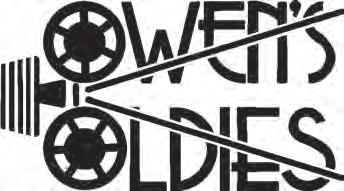
By Owen Glancy Arts & Features Editor
For those with keen memories, you might remember that the first Owen’s Oldies was on “Umbrellas of Cherbourg,” a French film from 1964 directed by Jacques Demy. After almost four semesters of publishing Owen’s Oldies, covering another one of Demy’s colorful masterpieces is well overdue. Unlike most of his work, “Donkey Skin” does not make the ordinary and mundane whimsical and romantic. It instead is a more traditional fairy tale forgoing the contemporary setting and the logic that comes with that setting.
That shift in his focus came with the end of the French New Wave film movement of the early 1960s, a movement which Demy was a crucial part of, both in his works and in his marriage to Agnès Varda, the female progenitor of the movement. By 1970, the year of “Donkey Skin’s” release, Demy had moved past the French New Wave’s focus on tackling the contemporary France setting, but brought the lessons learned in the French New Wave with him to this film. He combines the traditional fairy tale influences with his modern filmmaking sensibilities.
The tale of a beautiful prin -
his discovery of a museum’s closed Voyager 1 spacecraft exhibit, where he found out there was a chance of someone, something, out there, and they might want him in a way people on Earth don’t. Within every plot point of this movie, I found myself gravitationally pulled toward my TV, with laughter ripped out of my ribcage, a gasp stolen from my lungs, and tears cascading down
to play with this movie. I was starstruck.
It felt so real in the most unhinged way, because of course I couldn’t compare watching a baby alien being swaddled by its dad alien to a real human experience, but for some reason it was as if I were really there.
The number of times I cried thinking, “oh gosh, this hits so close to home” was five too many.
There are layers upon layers to this film. The good, the bad, the funny - the horror - I

my cheek. I’m honestly mad at Pixar for creating a movie this good after “Luca” (my favorite movie).
And it doesn’t stop at the stellar script. No, the movie sends my emotions sky-rocketing with out-of-this-world animation. The lighting, character design, set design, and the sound, everything dazzled with these cosmic creative decisions. Pixar did NOT come
cess who has to go into hiding to avoid marrying her father who is in the throes of grief after his wife passed away is very similar to something that the Brothers Grimm would have written, but it forgoes to the dark overtones and instead
couldn’t fit every feeling I felt watching this movie onto the silly sheets meant to help you find your current emotion.
When asked “which one of these is you,” it felt like Elio could see me when he looked at the emotions sheet, shrugged, pointed at the face labelled overwhelmed, and casually said, “I don’t know, but I think this one is you.” Cue the
A major stand out aspect of the film’s elegant production design are the costumes. Early in the film, the princess, played by Demy regular Catherine Deneuve, has her father the king make her a series of increasingly elaborate dress -

leans into Demy’s signature brand of technicolor whimsy. The film’s biggest departure from these Tales of Grimm-esque plots is its ending. While it might be silly to write around spoilers for a 55-year-old movie, I hesitate to so quickly give away how it ends because so much of the film’s magic is in that ending which is both predictable and completely out of left field.
es in order to delay her marriage to him. Every single one of these dresses is absolutely stunning, with them all being themed around the moon, the sun, and the stars. And these dresses are just the tip of the film’s costume design iceberg, with the most iconic outfit also belonging to the princess, the titular donkey skin she wears in hiding. While not a full blown mu -
camera panning up at what seems to be a crazed woman.
The aliens created for this movie are a delight, each of them coming from different planets with their own personality and quirks. They banter in the silliest way and their character design was wonderful. From blob-ulous beings and robot geniuses, to the freaking Universal Users Manual who knows the meaning of life, every character felt like a friend. I kinda wanted to join them too.
The movie was particularly interesting because I love astronomy, and the number of references to space terms, be it planets, nebulas, spacecraft, and typical space jargon, was all the more reason for me to geek out about it. They even had an audio clip from Dr. Carl Sagan, one that brought me to tears each time.
I found myself going “he said the thing!” whenever Elio mentioned anything space related, and I don’t know if that’s what Pixar was going for with this movie, but if soyou got me!
There are many reasons to watch this film. The hilarious communication between humans and aliens plus the space puns are a big one, but, if I took anything away from this movie, and if it’s anything I can give to you, it’s that being different does not mean you’re alone.
And if you think you’re different, or alone, or both, I kindly ask you to rush to Disney+ and get cozy with some tissues, because you aren’t alone, and neither is Elio. OK, Bye. I love you.
CONNECT WITH LIV DUNLEAVY
sical like “Umbrellas of Cherbourg” or “Young Girls of Rochefort,” Demy still injects the film with a couple musical numbers and original songs. These songs are more reminiscent of the classic era of Disney animated musicals, once again building a fairy tale atmosphere using the audience’s familiarity with arguably the most famous film adaptations of famous fairy tales.
“Donkey Skin” was among the last films Demy would release before his death in 1990, and is often the last many people watch alongside “A Room in Town” thanks to their joint inclusion in a Criterion Collection box set of Demy’s work, and that is very apparent. His mastery over color, music, framing, and the actors is at its peak in this film, shaped by his films of the French New Wave and undoubtedly by the films of his wife Agnès Varda.
While “Umbrellas of Cherbourg” is the better film, it doesn’t have some of the clunkiness in the middle this film does.
“Donkey Skin” and the rest of Demy’s wonderful filmography should not be overlooked in favor of his most celebrated work. If you’ve watched “Umbrellas,” whether because of Owen’s Oldies or in your own time, please give “Donkey Skin” a shot. You’ll be pleasantly surprised by how much you like it. You can stream “Donkey Skin” on the Criterion Channel.
‘Donkey Skin’
Marcus Falcão / THE GATEPOST
Liv Dunleavy / THE GATEPOST
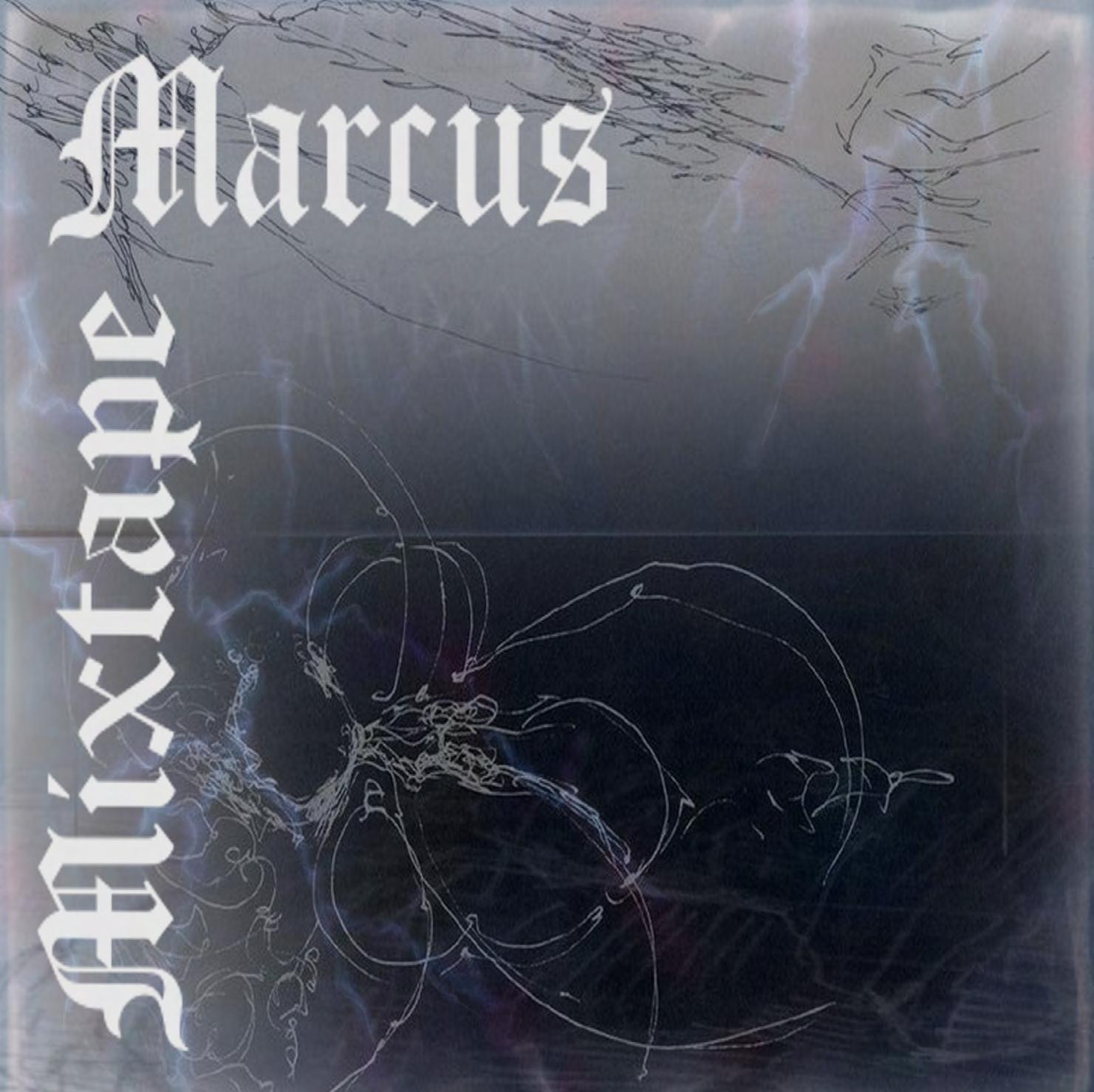
Puzzles

Pelvis sides
Past frat bro, say 9. Puts down routes?
“It hurts! It hurts!”
Neighbor of Ecuador
“Not that I’m ___ of”
Writing tool prototypes?
Cantaloupe or casaba
Head over heels
Ram’s mate
Worldwarping drug
Biblical song whose first letter is silent
27. Someone ___’s problem
29. Abbr. whose last letter stands for “as”
32. Legal representation demo?
36. Broadbodied ray
38. ___ eyes on (saw)
39. Giant in a fairy tale
40. In pursuit of
41. Roadside lodging
42. Code name or pen name
43. Quickly read
44. Surrender
45. Briefly worded
46. Proof-ofconcept storage area?
49. Enable to
50. P ___ Peppa Pig
51. Group of solar panels, say
53. Mime’s routine, e.g.
55. Hip-hopturned-K-pop band
57. Like someone whose mind is blown
61. Spud
63. Beta-stage film music?
66. Ritzy watch brand
67. “Garfield” canine
68. Target of DIY improvement
69. 007’s beginnings?
70. Feline murmur
71. Old Russian ruler
DOWN
1. Arizona tribe
2. “Beat ya!”
3. Approval rating gauge
4. Plunge like a hawk
5. Pop into sight
6. Director and Knicks fan Spike
7. Bulky coffee holder
8. Inspiration personified
9. ’90s 18-Down Anderson
10. Feeling of wonder
11. She may say “Grody to the max!”
12. Supplier of desire
13. Ctrl+Enter, in an email app
18. Couch potato’s idol
22. Join with a blowtorch
25. Flowers that might be white
26. The ’rents, perhaps
28. Super buff
29. Accumulate
30. “The Metamorphosis” author
31. Particle physics topic
33. Not curved
34. Clear, as a blackboard
35. Expired password action
37. Fill-in workers
42. Squads of starters
44. Iota of cash
47. September 23-October 22 zodiac bunch
48. Asteroid’s “footprint”
52. Upscale boat
53. Sweeping in scope
54. Was in attendance
56. Cease
58. Places to see giraffes and jaguars
59. Bombeck dubbed the “Socrates of the ironing board”
60. Forest sprinter
62. Mental “me”
64. berkeley. or berklee. follower
65 “Ma’am” for a man



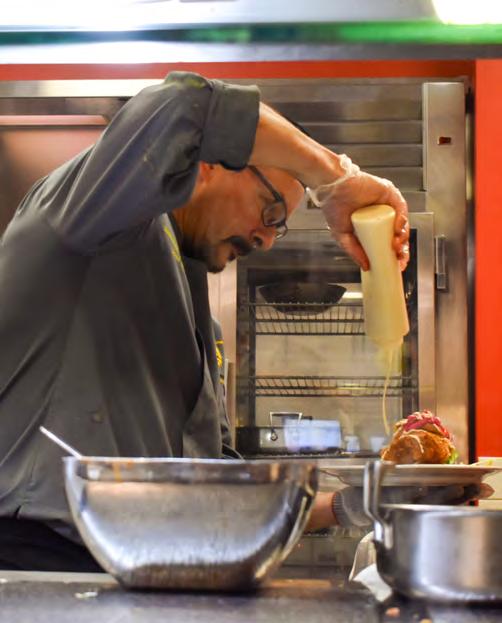
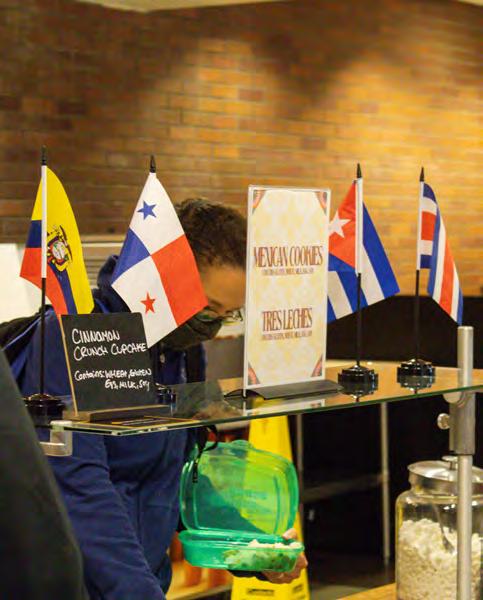
Hispanic HERITAGE CELEBRATING
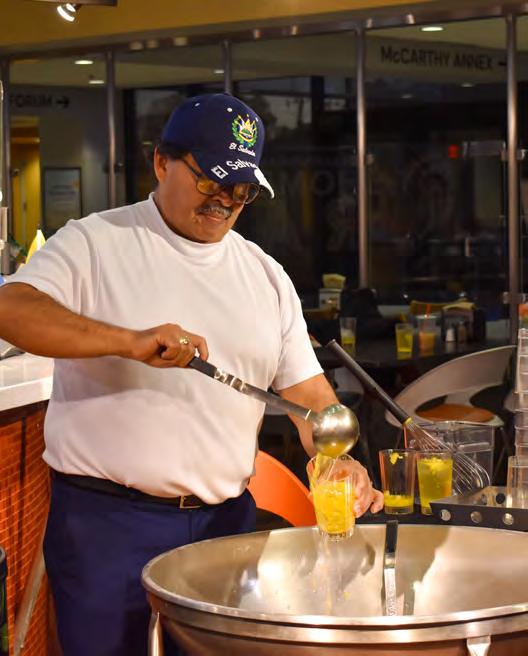
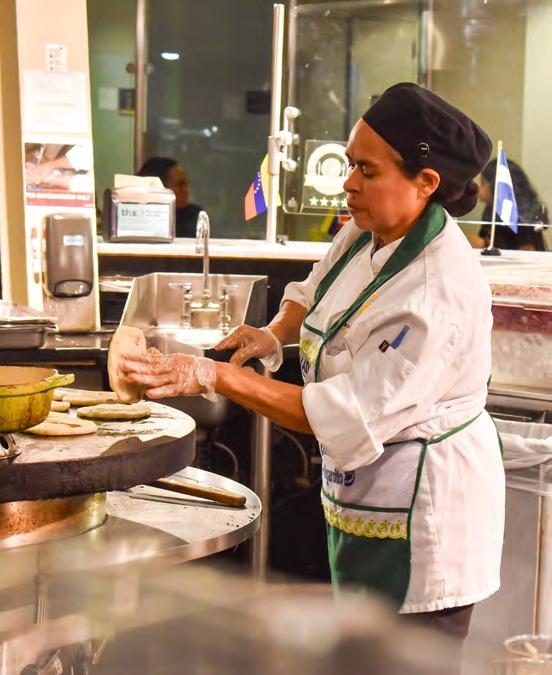




Photos and Spread by Associate Editor Adrien Gobin
